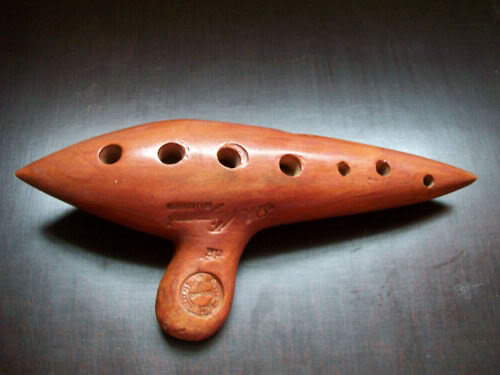
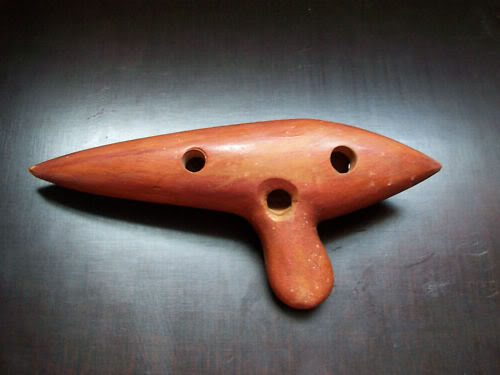
version 60
Last updated: June 2016
TinyURL: http://tinyurl.com/italian-ocarina
Italian translation by Elisa Mazzariol (June 2015; 2.7Mb PDF)
The Italian ocarina is not a very familiar instrument. Its distinctive sound has featured in enough recordings and film scores that most people in the developed world have heard it, but most of them couldn't have put a name to what they were hearing. Despite its obscurity, its sound can make a great contribution to many kinds of music. This is a musician's guide to its possibilities and its place in the world.
An excellent very short video about the instrument's history and how it's made, presented by a leading contemporary maker:
Italian ocarinas are shaped like an airship. There is a windway feeding air to a soundhole, formed like the corresponding parts of a whistle or recorder, which connects to an internal cavity punctured with holes for the fingers and thumbs - two thumbholes underneath and eight fingerholes on top.


Arrigo Mignani ocarina, mid-20th century
Their acoustics is unlike a tubular flute (whistle, recorder, or transverse flute); instead of a standing wave along the tube, the whole mass of air inside the cavity pulsates in and out. (In the Sachs-Hornbostel classification used in ethnomusicology, which classifies instruments by their physics of sound production, they are given index number 421.221.422). There is no way to get higher harmonics as there is with a whistle; an ocarina has limited range.
But it's very powerful over that range. Instruments in the same family are the samba whistle and the referee's whistle; an ocarina isn't quite as loud as that, but usually more powerful than a tubular flute of similar pitch. The original idea of the instrument was as an outdoor one, playing Italian tunes for dancing and other public festivities - the same kind of role as the accordion and bagpipe, which are much less portable, more expensive and have much more to go wrong.
Unlike tubular flutes, the order in which you put your fingers down to play a scale isn't fixed. The pitch you get depends only on the total area of holes left open; this means that there are many more alternative fingerings for the same note, and by using the smaller holes you can get precise microtonal fingerings. The pitch bends easily if you blow more or less strongly; this can be seen as either a bug or a feature, but it does mean that almost any ocarina can be played in tune with almost any instrument, and bluesy slides are easy.
And for the Italian 10-hole ocarina, the response to adding or removing fingers is usually very fast - quicker than a whistle, recorder or flute costing much more.
What that all means is that for the right music, and for a player who knows how to use it, the Italian ocarina has unique advantages.
This type of ocarina was invented by Giuseppe Donati of Budrio in 1853. This is one of Donati's originals:
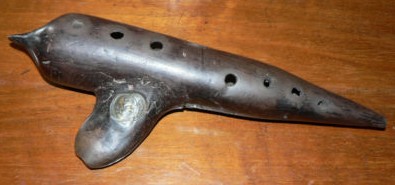
Donati ocarina
There had been "globe flutes" of various types all over the world for thousands of years, but Donati was the first to make one that played in a similar way to a Western woodwind instrument. This instrument is possibly the sort of thing Donati improved on; it was made by Niccola Robusto from Oliveto, near Naples, around 1900. It has fewer holes than a Donati and in a small range of sizes, so it must have had a very limited range, but would suit some southern Italian folkdance tunes, like those played on the "friscalettu" cane whistle.
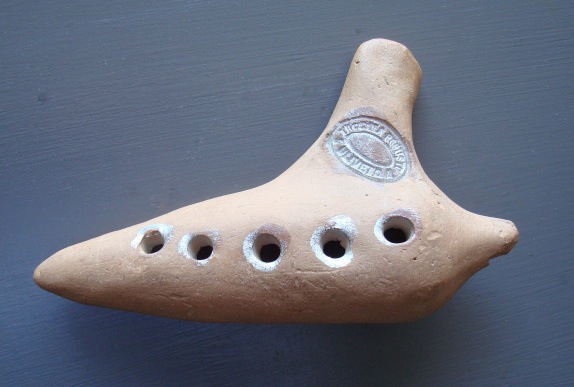
Neapolitan ocarina
Much simpler toy ocarinas shaped like birds were, and still are, common in Italy, the custom is believed to derive from ancient Greece:
Donati was a teenage baker's apprentice when he had this idea, and used his employer's bread oven to fire his experiments. It didn't take long before he set up his own ocarina production line.
These are modern instruments in the same tradition:
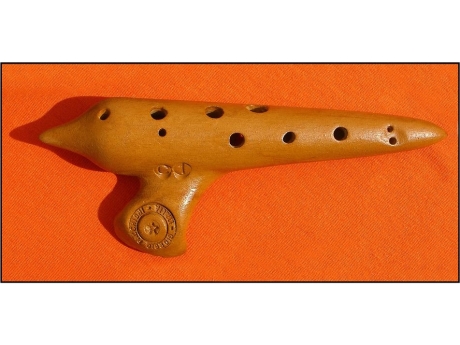
Giorgio Pacchioni ocarina in C
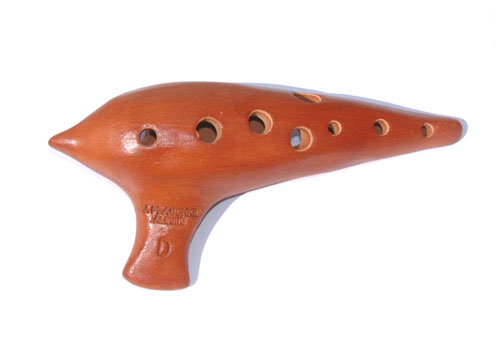
Wolfgang Plaschke ocarina in D
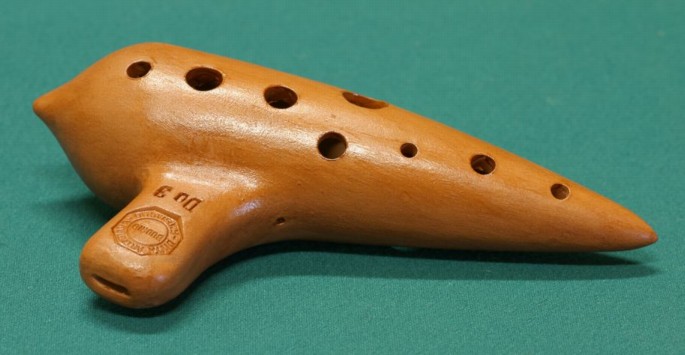
Menaglio "do-3" or "C3" ocarina
As on a conventional tubular woodwind instrument, as you take fingers off in sequence from little finger to thumb, right hand then left, the pitch goes upward in a conventional scale. The exceptions to the obvious pattern are to help you hold it: you want a thumb underneath and a finger on top to help balance it, since ocarinas are small, fragile and easy to drop.
An early idea by the Italian makers of these instruments in the 19th century was to emulate other families of instruments (like brass) and form consorts of different pitches. They tried to standardize a group of seven, all playing different pitches in C and G, like this Italian ocarina band from 1911 (picture from an EBay auction):
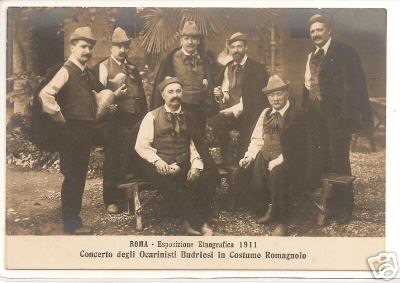
Budrio ocarina band, 1911
There are still groups based around the Budrio factory and in nearby parts of northern Italy continuing that tradition:
A demonstration of some different sizes, from Chris Heuer of Sixth Street Ocarina in the US:
The larger sizes were always very expensive (the bass was the size of a chicken, very difficult to make), so this idea didn't catch on except as a niche interest. But the instrument in its smaller sizes did, in many other countries around 1900. The Mezzetti brothers from Budrio moved to France and England; one made ocarinas in Paris, the other popularized the instrument in Britain. These are the Mezzettis I have (all tunable: soprano in G, alto in B flat, alto in G):
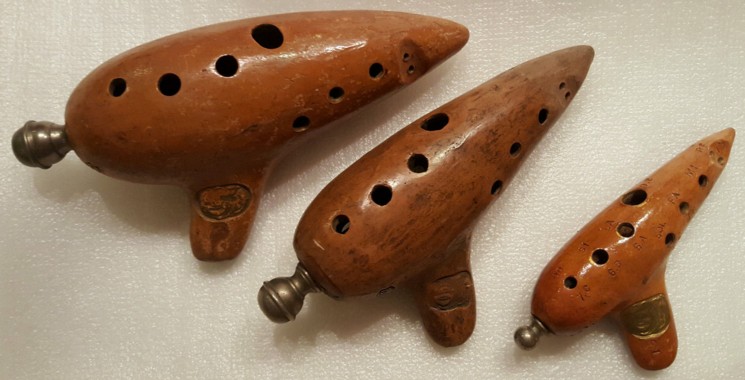
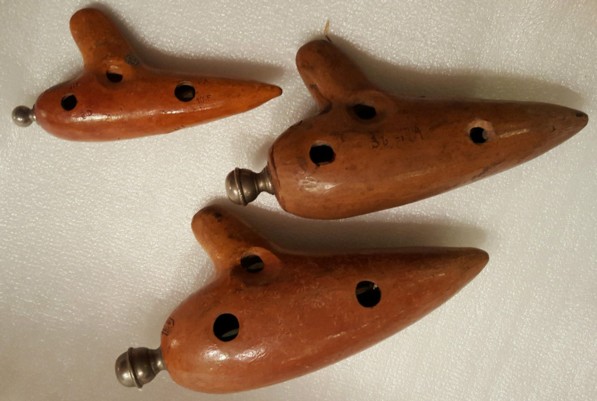
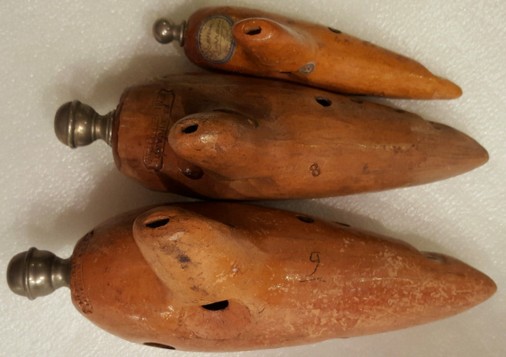
Another one:
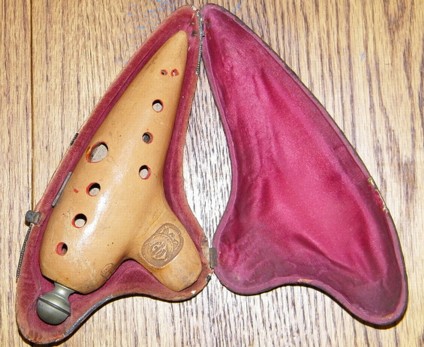
Tunable Mezzetti ocarina in fitted case; from Jafafa Hots's photo page
Even further upmarket was this de luxe instrument, perhaps by Ercole Roda in France, which had silver-inlaid fingerholes:
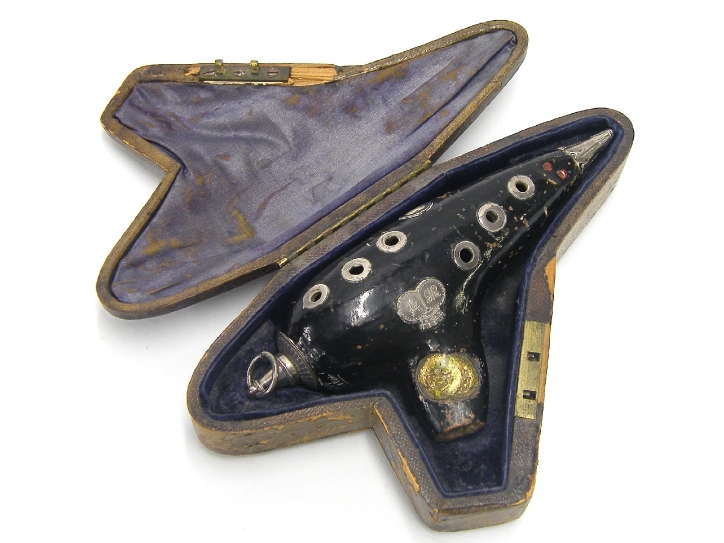
Tunable ocarina in fitted case with silver-inlaid fingerholes; from a 2013 auction at Gardiner Houlgate in Bath, England
Tunability was achieved by pulling a metal tube out, increasng the internal volume of the instrument. It wasn't very useful - the range it could usefully cover was only about a quartertone, and tuning slides are rarely made now.
Ocarinas were brought to Bavaria by Italian migrant workers and became a standard folk instrument there, and were made in Austria on a large scale.
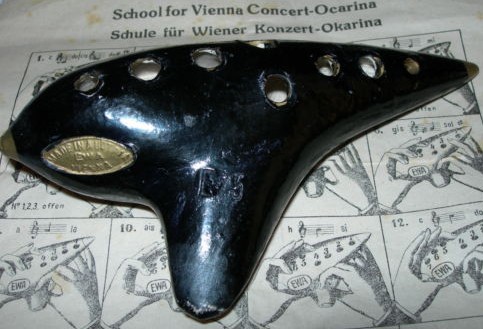
Austrian EWA ocarina in D
This is a German one:
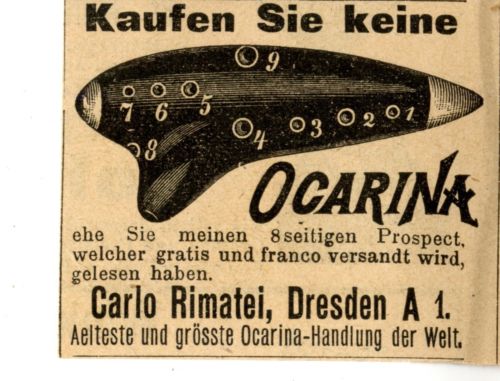
Advert from Carlo Rimatei, Dresden
A later and astonishing Italian ocarina missionary in Germany was Idelmo Fecchio from Grillara in the Po delta, who used his ocarina making skills to survive when a prisoner in Germany during World War II. While sheltering in a bomb crater from an Allied air attack, he realized that the clay in the crater could be used to make ocarinas, and sold them to his captors to buy food. The story (in Italian) is on his memorial page.
From Austria they made their way to the US, and were sold all across the country, as in this section from the 1895 mail order catalogue from Montgomery Ward, advertising Austrian ocarinas:
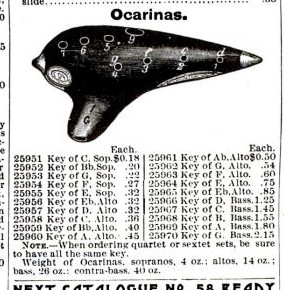
EWA ocarinas?
They also got to Japan, Romania and Bulgaria. Romania probably made more of them than any country outside Italy and the instrument is still played there at a professional level.
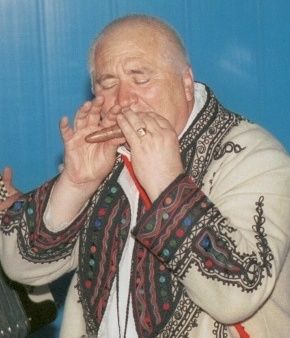
Stefan Popescu, Romania, 2005; image from eliznik.org.uk
Here is one that made its way to South Africa, apparently used by a policeman in Namibia in 1921:
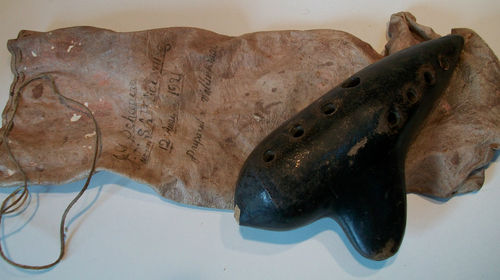
Ocarina used in Namibia in 1921
In America, the Italian ocarina band was adapted (at least in one instance) into a version of the old military flute band dating back to colonial times:
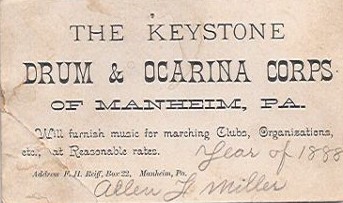
Wherever they went, they became an instrument of the proletariat or the peasantry because they were cheap and mass produced, and they attracted the stigma that all such instruments get. At first they were only made in fired clay - still the commonest material used for good quality ocarinas - but the French firm Mathieu made them in cast pot metal in the early 20th century. Here are two of my ocarinas from that time, one in pottery made in Vienna and one in metal made in Paris, in top and bottom views:
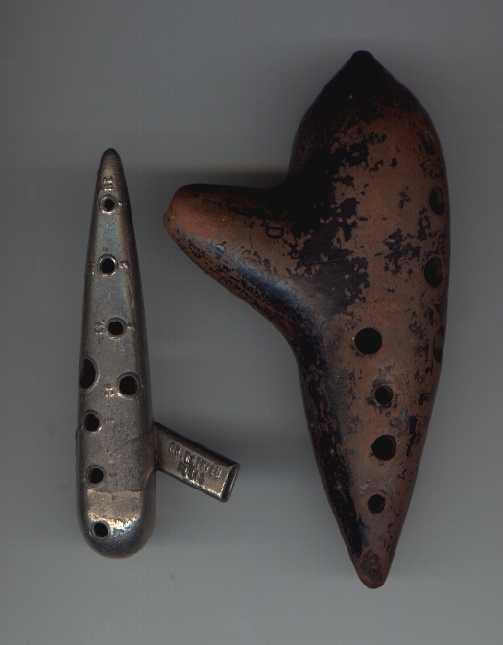
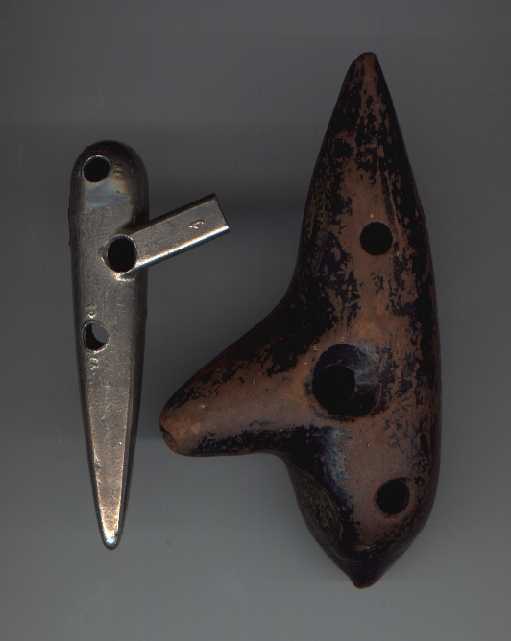
Mathieu metal and Fiehn pottery ocarinas from around 1910
Either, but particularly the metal one, gets me the attention of airport security x-ray staff all over Europe. But only in Italy have I been asked to demonstrate by playing a tune on it.
Here is another metal ocarina, from an EBay auction (item 3758795631). It seems to be basically the same design as my metal one but in G and with a ring for a lanyard:
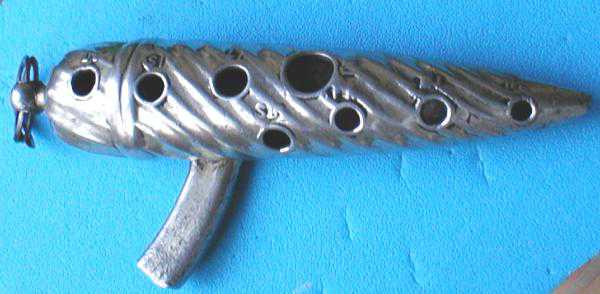
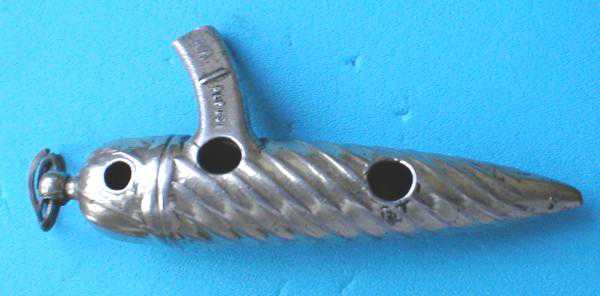
One of these French ocarinas must have been the stage equipment of perhaps the oddest act ever to feature the instrument. The music-hall "fartist" Joseph Pujol, "Le Petomane", had this as the finale of his show:
Returning to full view on stage with rubber tubing inserted in his anus, Le Petomane demonstrated his mastery of the anal arts by smoking a cigarette through the tube, while commenting on its flavor. Building to an absurdist anti-climax, Le Petomane attached an ocarina to the tube and played popular show tunes. Then he would begin singing as he played the ocarina, and to enable emotional identification, Le Petomane conducted an audience sing-along accompanied by his anal instrument. (More at The Gift of the Singing Sphincter).
Two of the tunes he played were O Sole Mio and La Marseillaise.
This German ocarina from 1893, described as "absolutely unbreakable", must have been made of metal, but isn't a copy of a Mathieu:
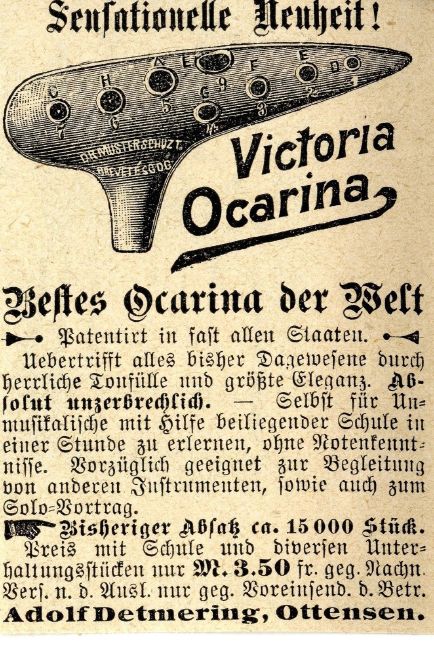
One particularly attractive design was by the Meissen pottery, near Dresden in Germany. These were made of porcelain, which is a difficult material to work with the precision needed to make an accurately tuned ocarina, and the "blue onion" decoration was applied by hand painting, so they were and still are expensive:
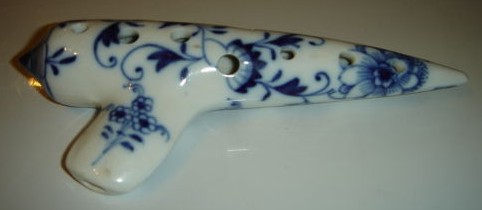
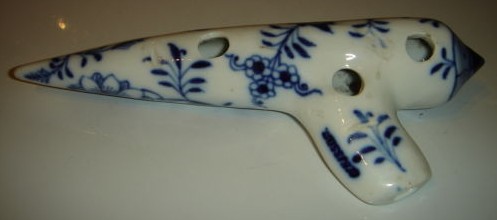
Meissen ocarina
The sound didn't always match the appearance. Modern replicas of these (in ordinary earthenware, by Hans Rotter in Austria) are more dependably good as musical instruments.
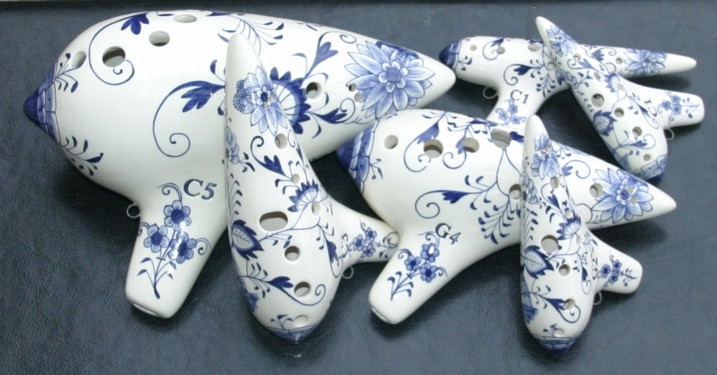
Hans Rotter Meissen-style ocarinas
Early American attempts at ocarina making were of mixed success. The Teschner firm in New York State made instruments similar to Italian or Austrian types:
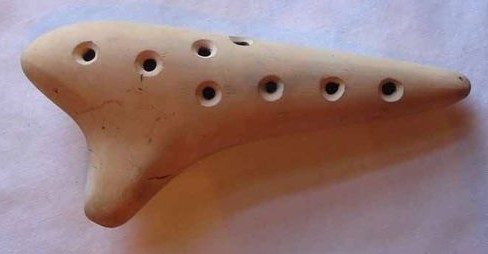
Teschner ocarina, image from an EBay auction
but had to fight against competition from European makers like Fiehn:
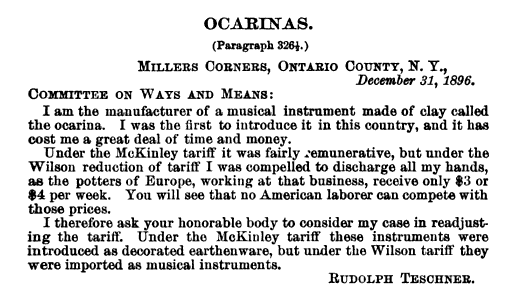
Teschner writes to Congress about being undercut
The Italian emigrant Guido Bondi made (usually not very good) Budrio-style ocarinas in Kentucky, like this bass:
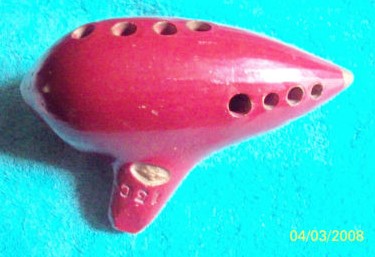
Guido Bondi ocarina
A set of Bondi ocarinas was used in the soundtrack of the film of The Wizard of Oz, for the song If I Only Had A Brain.
This design by Harry Bernard was a bizarre experiment, with the basic fingering following the wholetone scale with auxiliary holes to raise the pitch by a semitone:
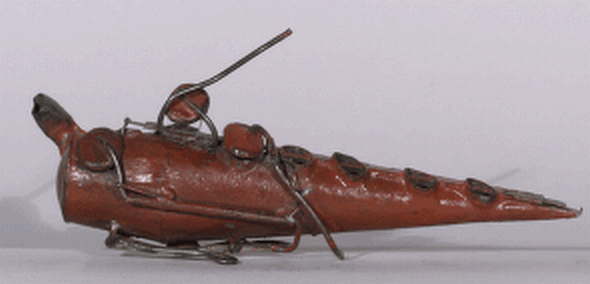
Keyed ocarina by Harry Bernard, Pennsylvania 1910
A common American word for the ocarina was "sweet potato flute", and they still turn up on EBay under that name. They were often referred to in popular culture under either name.
A group of teenage boys in the US in the 1930s produced a small number of "potato bug" or "Superino" ocarinas made of laminated wood, and performed as a band with them. Charlie Hind's website has a well researched historical article telling their story. Similar designs are made today by Hind in the US and Hyunil Ko (trading as Woodsound) in South Korea. They are hard to make and very expensive.
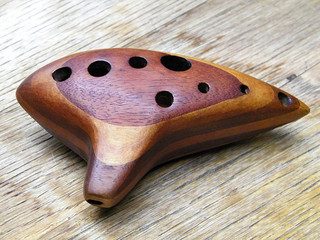
Potato bug ocarina, from Jafafa Hots Flickr page
Sometime in the 1930s the American firm Gretsch started making ocarinas out of thermosetting plastics. These plastic ocarinas were sold in large numbers to the US military during WW2, with tunebooks and instructional materials to go along with them (an ideal soldier's instrument - light and pocketable, resistant to jungle mould). Here is a story about one that survived into the 1970s and (with the assistance of some LSD) inspired a Captain Beefheart song:
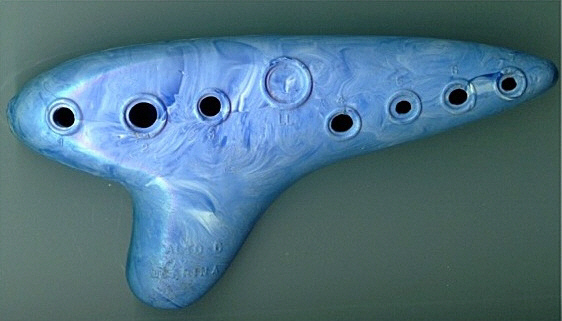
Most seem to have been blue like that one, but there were pink ones made for women in the US forces overseas. According to the Gretsch company timeline, which doesn't mention their ocarinas, the company stopped making instruments between 1942 and 1946 to assist in the war effort; so perhaps the supply was drying up by the later phases of the war.
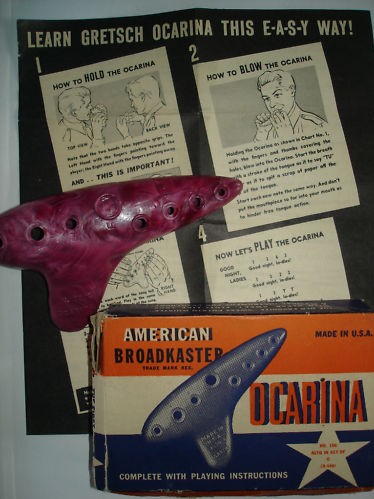
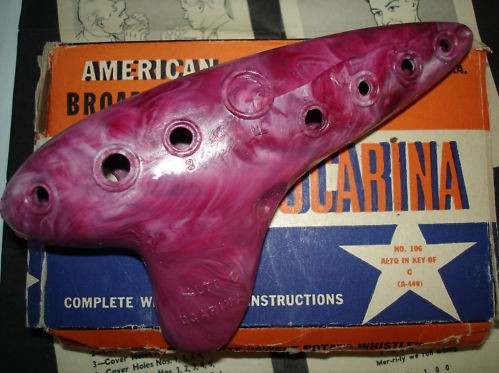
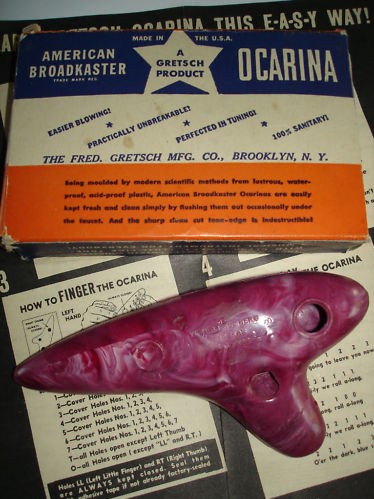
You can see in those pictures that two of the holes were left unpierced; these were for the highest notes and were considered "advanced", so you filed them out when you got good enough to use them. (Maybe. They might not have worked at all).
Gretsch ocarinas were even produced in sets with standard sizes to equip military ocarina quartets. Here is the cover of a collection of music published for these:
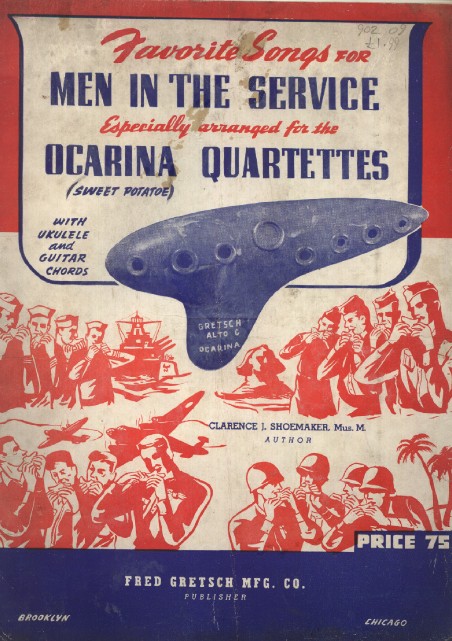
and there was an instruction book (downloadable from Giorgio Pacchioni's site; this requires registration) or here in PDF format
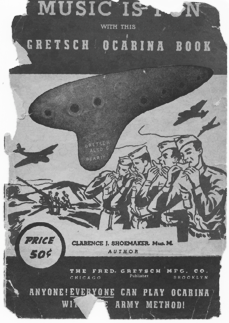
There can't be many complete quartet sets of Gretsch ocarinas for the military still in existence. This is a set of photos of the full package as it was sent out to the forces. The set may be for sale - not from me, but I can provide the owner's details if anybody's interested.
If there are any veterans of the US military reading this who played in such a group when on active service, I'd like to hear from you. And if anybody out there has a set of the ocarinas and could record some of the tunes from the Gretsch books on them, please let me know.
The ocarina made it into the British Army as well; in Mussolini: My Part in his Downfall, Spike Milligan describes leading a singalong while fighting in Italy in 1943, with percussion accompaniment from a soldier bashing two boxes of matches together. Milligan doesn't say what sort of ocarina it was - it could equally well have been an American Gretsch or an Italian one.
A competing maker to Gretsch was the Waterbury Button Company, who made bakelite ocarinas with a distinctive eagle motif. Bakelite is a good material for ocarinas (hard and resonant) but these weren't very good instruments. (They have US patent number 2,195,992 dated April 2, 1940, with the inventor named as George A. Mausolf - scans of the patent are in several places on the web).
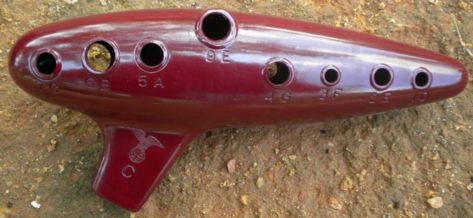
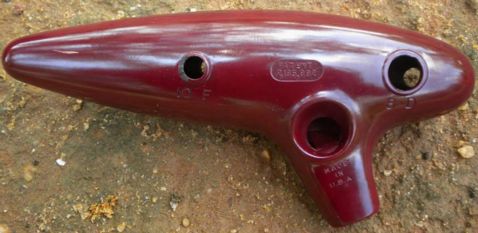
Waterbury ocarina (they were more usually black)
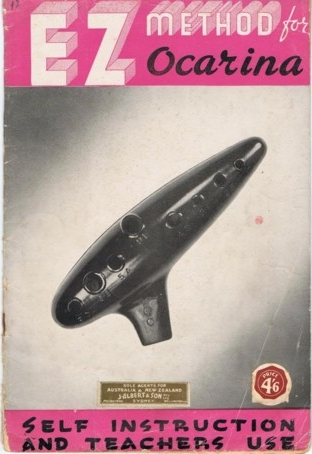
Method for the Waterbury ocarina, as sold in Australia
The cheapness of these plastic ocarinas allowed bizarre crazes like this to happen:
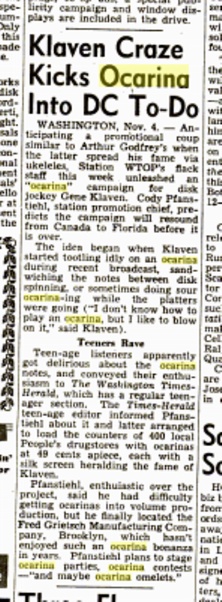
Billboard magazine, 11 Nov 1950
Something very similar to the Gretsch - so similar that it might be made from the same moulds - is still made. It doesn't have a very good reputation for playability but it's ridiculously cheap:
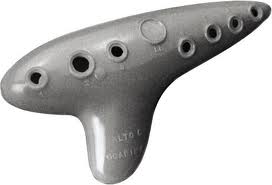
First Note ocarina
A similarly crude and cheap plastic ocarina, but of a different design, is sold very widely around the world under many brand names, "Dadi" being the commonest. Here's one of them. They don't sound very good.
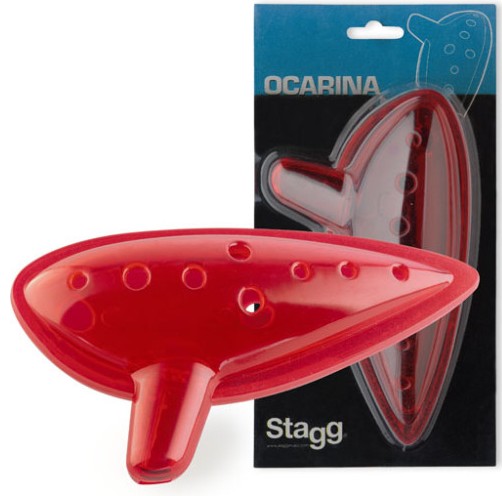
Stagg ocarina
Until the 1960s, ocarinas were fairly common in Britain, sold at the same price range as mouth organs. These seem to have usually been plastic and not very good. In Scotland in the 1950s, they were sometimes given away free by rag collectors to people who gave them old clothes for recycling. I have seen one in a similar design to this French model which may have arrived in Scotland that way ("blow here" moulded into the mouthpiece suggests they didn't have a very sophisticated clientele in mind):
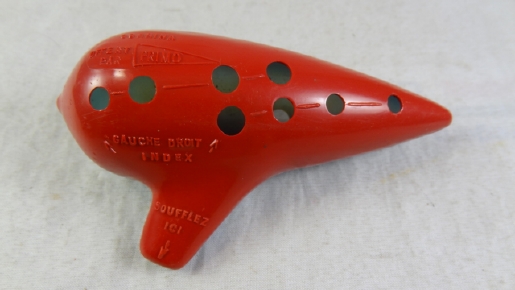
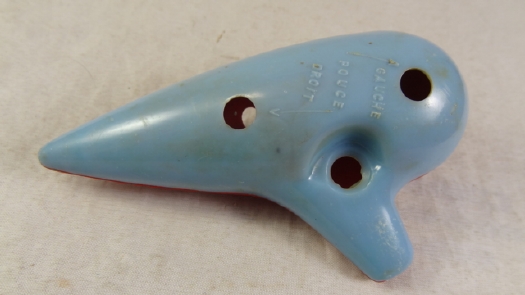
French plastic ocarina
But genuinely usable ocarinas were available as well.
From the beginning ocarinas have been made in many different sizes (the bigger the deeper), to be played together. This is the current product line of the Austrian maker Hans Rotter - other makers have a comparable assortment.
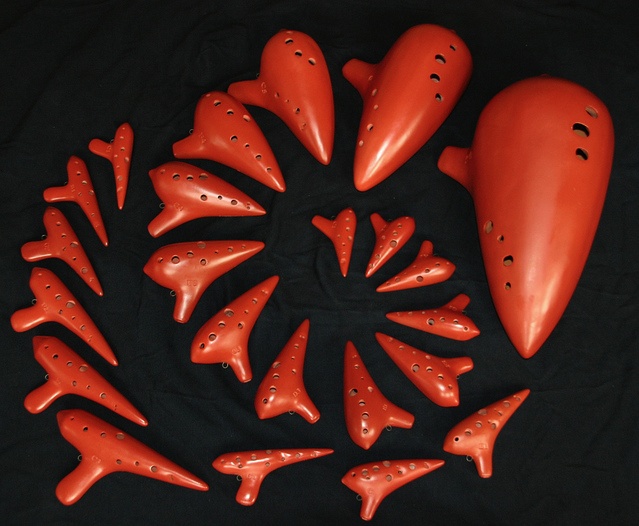
Rotter ocarinas - photo by "fenrisfang" on Flickr
The consort scheme developed by Donati and still followed by most European makers has seven sizes with the all-fingers-down note alternating between C and G - low to high, C7, G6, C5, G4, C3, G2, C1. Comparing with other instruments, the lowest note of the C5 was middle C and its range is the lower end of the range of a normal flute; the G4 fell into the lower end of the range of the alto recorder; the C3 ("alto C" in American and Far Eastern makers' terminology) fitted into the lower end of the range of a descant recorder and mostly into that of an ordinary D whistle; the G2 was comparable to a sopranino recorder; and the C1 to a garklein recorder. Most makers have always made ocarinas in many other pitches. The numbering scheme used by Austrian makers seems to have counted every pitch in the catalogue, so you find their instruments bearing numbers like G23 (which on Donati's scheme would be the size of a whale). Compared with other instrument families, ocarinas don't go very deep - a C7 ocarina, the largest commonly made, only goes as low as the low C on a viola. Because the sound is an almost pure sine wave they sound deeper than they are.
There is a small museum in Budrio devoted to the ocarina:
Music derived from the idiom of 19th century salon music for the flute was written for the ocarina in its early years:
Ocarinas were recorded very early. Here is a commercially released Edison cylinder recording which I first found linked from a site that has an interesting explanation of why the ocarina was seen as having commercial potential, since this was an era when exotic sounds were being popularized by the recording industry:
Probably the most-recorded ocarina player ever was Mose Tapiero, who cut a large number of 78s in the first decade of the 20th century.
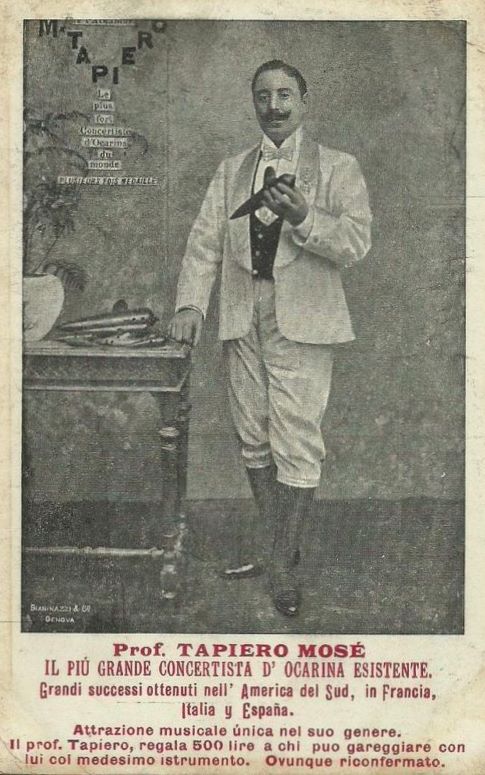
Here are a few videos and mp3 files showing what the Italian type of ocarina can do, in as many different idioms as I can find.
The ocarina is, acoustically, based on the principle of the Helmholtz resonator; this means that the pitch varies with the volume of the instrument and the cross-sectional area of holes open. Exactly which holes are open doesn't make any difference to the pitch you get, so long as the open area is the same. So there are more opportunities for alternate fingerings than with most other woodwinds.
Following the usual convention for this type of ocarina, I've named the pitch of an ocarina as the note you get with all fingers and both thumbs down. Seven-fingers-down is the convention used for recorders; whistles have their pitch named after the six-finger note, a tone higher, so a C ocarina plays much like a C recorder (with German fingering) or D whistle (but with a natural F).
Here are some suggested fingerings for an ocarina in C, using cross-fingerings for chromatic notes. The note names use ABC conventions, so ^F is F sharp and _B is B flat. (The sol-fa names follow the Curwen system). Ocarinas are not all the same, and most notes can be bent a lot by varying breath pressure, so you may want to use different fingerings than these. Ocarinas vary most and are most pressure-sensitive at the top end of the range. For some, the top two notes are so out of tune or whispery as to be useless. (There's a lot of nine-note music available, so that doesn't make the instrument a write-off).
Some instruments have a split right-hand little finger hole, like a Baroque recorder, to make the semitone at the bottom easier to play. They have 11 holes but their acoustics and range is that of an ordinary 10-hole.
left right
==== =====
C do T1234 t1234
^C de T1234 t1234/ (half-hole)
D re T1234 t123-
_E ma T1234 t12-4
E mi T1234 t12--
F fa T1234 t1---
^F fe T1234 t--3-
G so T1234 t----
^G se T12-4 t--3-
A la T12-4 t----
_B ta T1--4 t--3-
B ti T1--4 t----
c do T---4 t----
^c de -1--4 t----
d re ----4 t----
_e ma ----4 ----- (Italian system)
_e ma ----- t---- (Austrian system)
e mi ----- t---- (Italian system)
e mi ----4 ----- (Austrian system)
f fa ----- -----
The rationale is to balance the instrument between left little finger and right thumb for as long as possible. Getting the top note without dropping the thing is tricky. (Another problem I have with the smallest ocarinas is getting my moustache mixed up with my fingers, as the left hand fingerholes are very close to the lips). You can see the difference between the Italian and Austrian systems even in a picture: the left-hand little finger hole is larger than the right thumbhole in the Italian system and the other way round in the Austrian one. The Italian system is a bit easier for music in keys with less than two flats, but there isn't much in it.
Semitones are achieved by cross-fingering. Using different fingers than the ones listed in the table may sometimes give better intonation or allow for microtonal variations (as in meantone intonation or Middle Eastern modal systems). It is also possible to get intermediate pitches and pitch slides by half-holing. It's as good for playing "in the cracks" as any fretless stringed instrument.
The semitones are easy enough that it makes no sense to say an ocarina is for a specific key - some makers describe their C pitch instruments as being "in C major", but there is nothing about them that makes this key easier than others. In fact D and G are the easiest keys on C ocarinas, since extensive use of the low C makes for difficult intonation (the note is not as stable as higher ones) and hard work for the right hand little finger. The ease of playing in one or two sharps makes a C ocarina rather more useful for the fiddle-influenced traditional music of Europe and North America than the tutorial materials provided by downmarket manufacturers would suggest.
The Budrio ocarina makers attempted to market their instruments in sets of seven, and got people to arrange music for this combination. These arrangements use a transposition convention, also followed by Gretsch in their music for the military ocarina quartet, where all the music was notated as if played on a C ocarina. And most commercial ocarina makers follow the same policy, so they can sell their own music anthologies to learners. Which makes marketing sense for them, but for a player, it only makes sense if you intend to stick to the small and not very interesting repertoire of music arranged specifically for the ocarina. It's much more rewarding to play your own choice of repertoire, and that means reading the notes off the page as they printed for something else entirely (most likely, the human voice) - forget about transposition and read at pitch to fit ocarinas of different sizes (as recorder players have been doing for about 500 years).
The American ocarina culture has developed its own notational system, a "tablature" which only represents pitch with no hint of rhythm or dynamics. It looks like this:
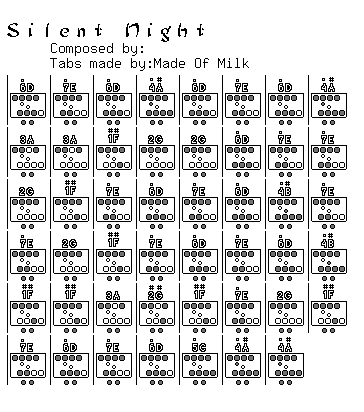
And since there are quite a few variant designs of ocarina, any tab notation like that is only useful to players who have exactly the same kind of ocarina as the transcriber. Not a good idea.
The best way to learn any instrument is first hand from a teacher who really knows the instrument. There is one such course for the Italian ocarina, at the Art Music School of Bologna, taught by Fabio Galliani: Corso di Ocarina 2014-2015 (in Italian).
This course on Romanian folk music and dance includes the ocarina: Banatfolk. Held in Romania and rather expensive.
There are many instruction methods you can use at home.
There have been other methods. I don't know of a scan of this one:
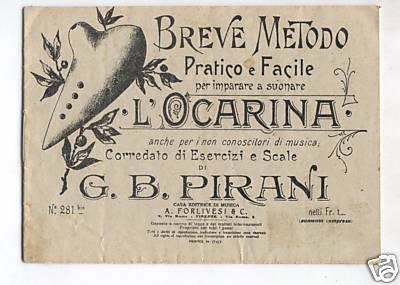
I have a copy of this, which I believe is very rare, and will scan it sometime (it isn't very good):
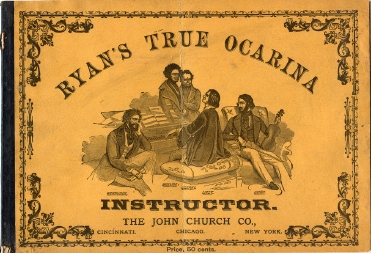
The sound of the ocarina is ear-catchingly weird. It will stand out in almost any instrumental group. It has very limited dynamic range without tone and intonation going way off, so you can't play on it both quietly and musically - if you don't have the confidence to handle the spotlight, just keep quiet.
To be more explicit, the dynamic range of a good Italian ocarina runs from very loud to ear-splitting. They were designed as instruments for the outdoors or for large halls, comparable in function to the trumpet, the accordion or the bagpipe. No other flute-like instrument comes anywhere near the volume of one of the higher-pitched members of the ocarina family (except just possibly the Catalan flabiol - I haven't played one). For a lot of folk music this is EXACTLY what you want.
Other instruments with limited dynamic and pitch range are folk shawms like the bombarde and duduk, the crumhorn, and most kind of bagpipe, so their repertoire will mostly work on the ocarina. Tunes for the Highland bagpipe are always written in the nine-note range from G above middle C to the A a ninth above that; if you intend to play a lot of Highland pipe tunes from sheet music you will need to learn to read it at pitch (which will be the correct concert pitch with a G ocarina - anything else and you'll need to transpose). Highland pipe music always has a key signature of two sharps, which isn't printed explicitly on the score. The fingering of the G ocarina is vaguely similar to that of the pipe chanter, so pipe tunes feel quite natural on it when done in the right key, and many of the standard pipers' gracenote patterns work "straight out of the box". Here is a comparison of the fingerings of the pipe chanter and the G ocarina:
ocarina chanter ======= ======= left right left right a ----4 t---- ---- 123- g T---4 t---- T--- 123- f# T1--4 t---- T1-- 123- e T12-4 t---- T12- 123- d T1234 t---- T123 ---4 (or T 123 ---- until recently) c# T1234 t--3- T123 1--4 (or T 123 1--- until recently) B T1234 t12-- T123 12-- A T1234 t123- T123 123- G T1234 t1234 T123 1234
Some folk music idioms have a lot of tunes fitting the ocarina's range - French and Bosnian music are examples. Others have rather little music to offer - Irish music is probably the least suitable, as its melodies tend to have wide range. But where it does work, it can work well. Vocal melodies usually fit: "Danny Boy" is the sort of song that doesn't (ranging over an octave and a sixth).
For other idioms: mediaeval music and Renaissance dance music usually works well, if you ignore historical plausibility (Guillaume de Machaut might have loved the ocarina but he certainly never heard anything like one). Later classical music usually calls for a wide range, which requires arrangements using several ocarinas. Idioms where almost everything is improvised - jazz, blues or the modal idioms of the Middle East and India - are a good fit because you can do a lot of slides and microtonal subtleties, and it's your music so you get to decide the range.
One thing an ocarina is NOT, is a good educational instrument. I wouldn't recommend any type of ocarina as a first instrument for anybody unless they've already developed a very good ear for pitch. It's far too pressure-sensitive - most notes can be varied in pitch by about a tone by blowing harder or softer.
I adopt the mediaeval musician's attitude that you play whatever fits your instrument, rather than looking for music consciously composed for it, and a lot of music fits the Italian ocarina with little need for adaptation.
Japanese makers between the wars developed a variant of the Italian ocarina with two additional small "subholes" which extend the range by a minor third at the bottom (they are left open except for these very low notes). In practice only one of them ever works; the ergonomics is awful, making these extra holes impossible to play at speed, and the lowest note is so much quieter than the rest of the range (typically by about 10dB) as to be useless for most music. They may also have a weak or rough-sounding top note, requiring bizarre contortions to sound it properly (a technique known as acute bend: look here at 1:00 and 1:11). For fundamental acoustical reasons, an ocarina can't much exceed an octave and a fourth in usable range; a 12-hole is trying to defy the laws of physics. The extended range mainly appeals to the gullible, or people playing themes from video games in their bedrooms. (Literally. There is a subculture of people who think of the ocarina as an instrument associated with video games, and put on headphones to play game music along with synthesized backing tracks. If you don't already know about this and aren't in search of the ultimate "Watching A Plank Warp" experience, I don't recommend trying to find out more).
The most influential figure in the ocarina culture of the Far East has been the Japanese player and maker Sojiro (whose technically flawless New Age music does absolutely nothing for me, but his sales figures say it appeals to a lot of folks):
In his career as a maker, Sojiro produced 10,000 ocarinas and kept 10 of them to play himself. You can imagine what an instrument by a first-rate maker and given that degree of quality control would cost - about 100 times what most 12-hole ocarinas on the market are priced at. And you get what you pay for.
Nonetheless, 12-hole ocarinas are very widely available in the US and the Far East, and can be very good in the midrange where most music lies in practice. (They can also be appalling across the whole range; only the most upmarket makers are consistent throughout their product line, so research the specific instrument you're thinking of before buying). This is a basic plastic model (picture borrowed from Lazy River Ocarina, a blog teaching the ocarina from the basics, from an American perspective):
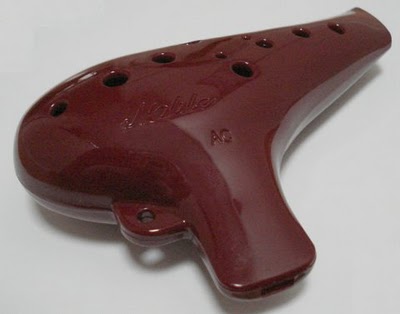
Noble alto C ocarina from Korea
There is a slight variation in the design of these ocarinas. The Noble ocarina has "Japanese subholes" - closed by the first and second fingers of the right hand. The alternative is "Taiwanese subholes", closed by the second finger of each hand. Some people think this matters. (Both of these ocarinas are reasonable value).
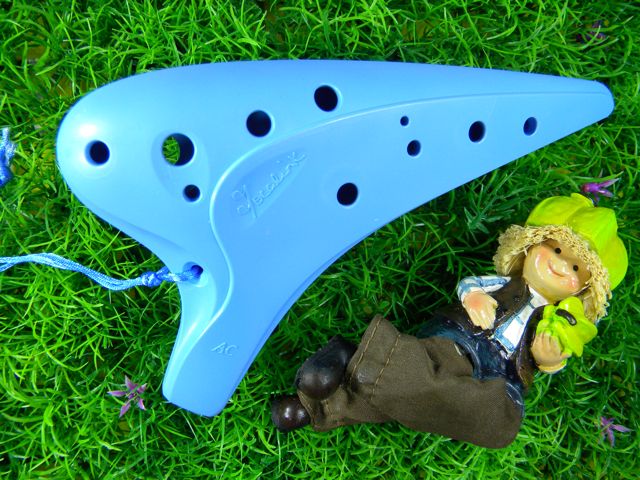
Focalink plastic alto C ocarina from Taiwan
This is one of the higher quality Asian-type ocarinas - a "Takashi" alto C ocarina by the Taiwanese maker Kuolong Pan (photos by Mark Chan).
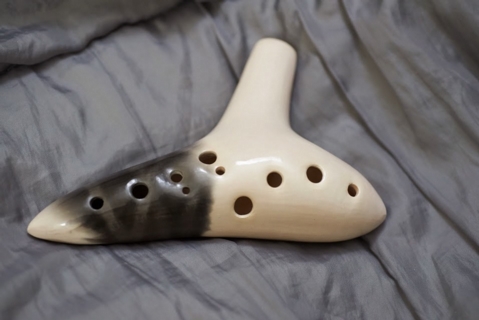
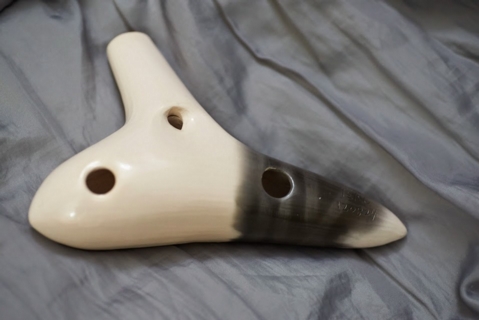
Takashi alto C ocarina, white with smoke finish
The ocarina is still subject to crazes as it was in the heyday of the Gretsch. The biggest one at present is the result of its use in the series of video games that began with Zelda: Ocarina of Time.
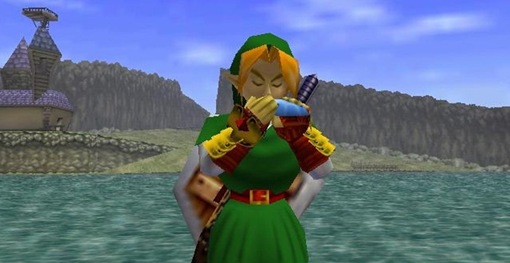
The Zelda character "Link" playing the ocarina
The ocarinas made to exploit the Zelda connection are of a variety of types despite their similar external appearance. Some are just plain weird; the ocarina depicted in the games has an unplayable fingerhole layout. Ocarinas made to look "Zelda-ish" always cost a lot more than those of comparable quality in other finishes. In increasing order of musical usefulness:
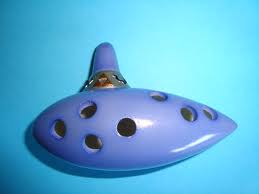
the Zelda ocarina, replica from the game, as played by elves
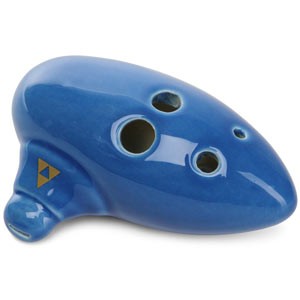
Zelda-themed Langley-fingered ocarina
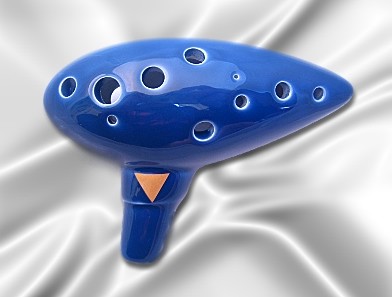
STL Zelda ocarina
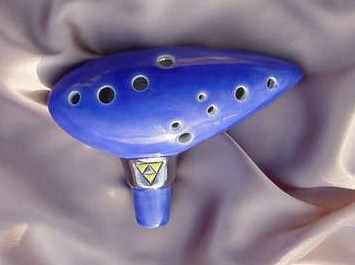
Spencer Zelda ocarina
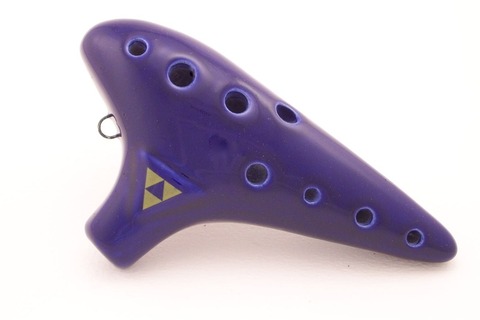
10-hole alto C Zelda ocarina from Sixth Street Ocarinas
But this ocarina, from another bit of Japanese culture that caught on worldwide, has an odd design (only three right fingerholes) unlike either the Oriental or Italian designs:
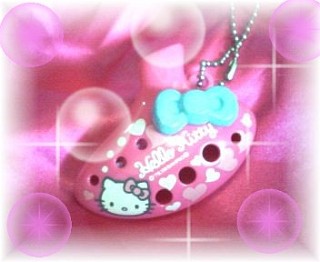
for the benefit of colourblind viewers, it's pink
Here are some examples of good ocarinas of the Oriental type being played well.
The only Oriental 12-hole ocarina I have sounds better than my old Austrian 10-hole ocarina at the same pitch, but in practice I use the Austrian one far more, since I never use the Oriental one's subholes and with the 10-hole I don't have to keep thinking about how not to close them by accident.
One extra subhole (extending the range downwards by a semitone) doesn't damage the instrument's performance detectably. Not many Oriental ocarinas are made with 11 holes, but some Italian makers do it, and the idea is slowly being adopted by small-scale makers elsewhere. Kurt Posch has his own version with a subhole instead of the top-end hole; this is intended for Austrian, Swiss and Bavarian folk music, which often has a semitone at the bottom of the range. The idea seems to be in use in other places in Eastern Europe, but I don't have much information about it.
This is a different idea for extending the instrument's range; the picture is taken from an EBay auction and I have never seen an instrument like this close up. It has two closed-standing keys for extra high notes. These probably didn't work any better than subholes do for low ones. A recent reinvention of the idea seems to have been a failure, with nobody demonstrating routine, effective use of the extreme top end that the keys are meant to provide.
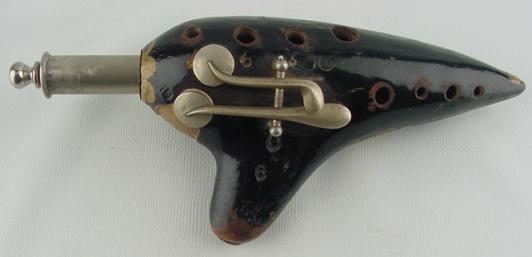
Because the ocarina can vary substantially in shape without the sound changing a lot, there have been a number of alternative designs over the years. One is the "in-line", basically tubular or cuboidal and blown at one end, with the fingerholes in two parallel rows or stretched out in one line. These probably go back into the distant past. A version made out of ibex or cow horn, the gemshorn, was used to a small extent in the late Middle Ages and Renaissance, though it had very limited range and was never explicitly specified in any score. (The modern gemshorn, with the same range and capability as an ocarina and available in consorts, seems to be a reinvention of a past that never was).
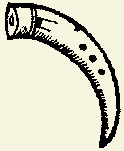
Gemshorn from Sebastian Virdung's "Musica getuscht", 1513
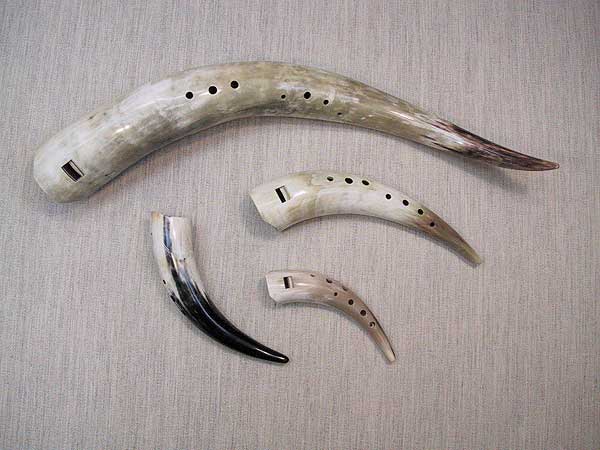
Gemshorns by Pavel Číp, from the Lazar Early Music site
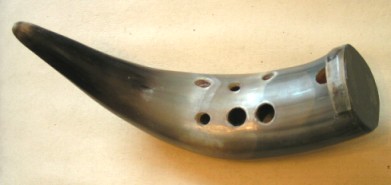
A Manchurian gemshorn from the Chinese firm Sound of Nature
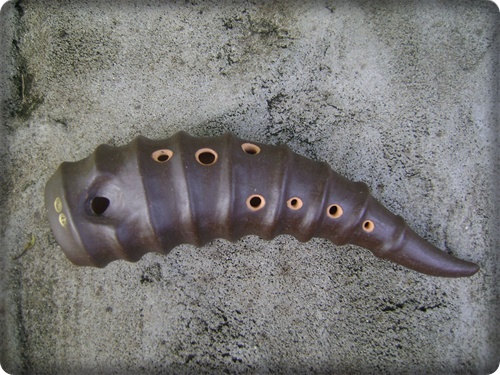
A ceramic gemshorn in A flat from the Thai ocarina maker Dinda (since many surviving gemshorns from the Renaissance were made out of ceramic in horn shapes, this is historically authentic though not advertised as such)
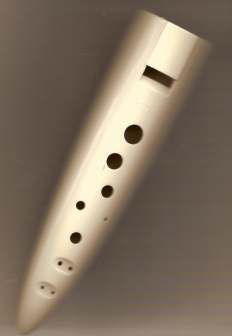
A plastic gemshorn from the US maker Susato
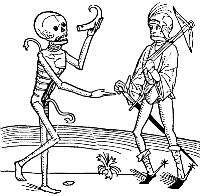
Renaissance woodcut: Death bearing a gemshorn
A folk variant of the same idea, in ceramic, is the Ukrainian zozulytsia, adopted as a national symbol for the European Cup in 2012. Several recent makers have reinvented the in-line, often using modern materials. The earlier designs have all the holes in one line (and look like whistles, though the closed chamber makes them play as ocarinas); more recent ones have parallel offset lines of holes. The most popular of the older type were the American "Tonette" and "Song Flute".
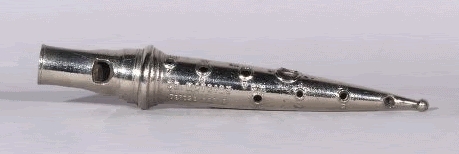
The Mathieu Ocariflute, from the early 20th century
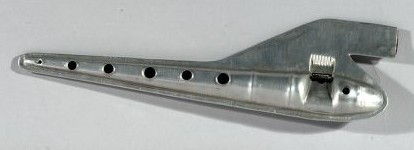
Metal inline (US patent 1788613) by the early 20th century American maker Harry Bernard
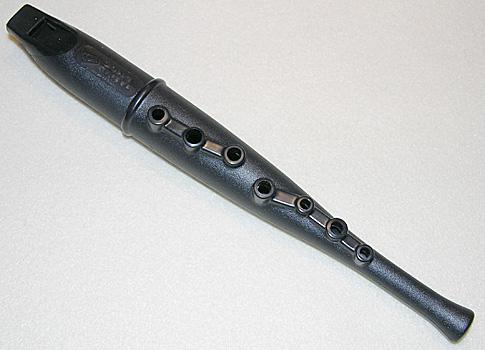
The Swanson Tonette, from the mid-20th century
Somewhat later the ceramic ocarina maker Guido Bondi, based in Kentucky, developed his own type of in-line. The photos suggest a good quality instrument but I have no information about their sound:
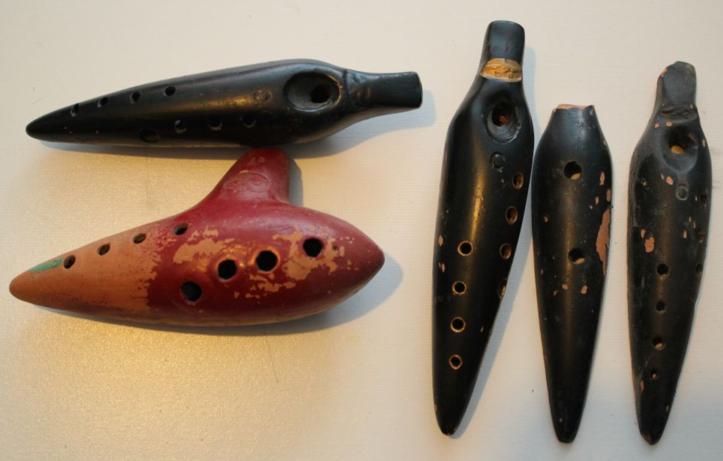
Collection of Bondi ocarinas, found in the ruins of his house
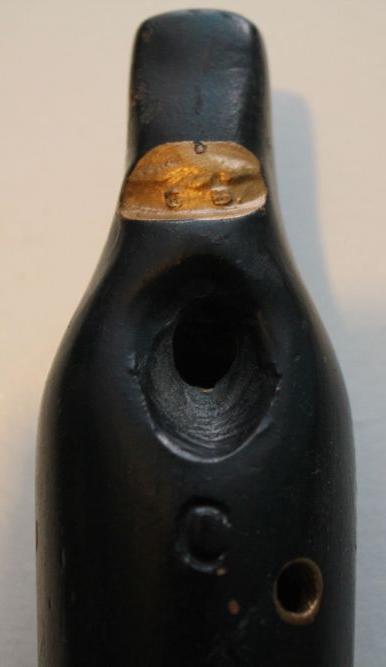
The voicing of a Bondi in-line
Videos of in-lines in use:
The most affordable and easily available (in the UK) in-line ocarina is a plastic one made by Mountain Ocarinas in the US; it has a box-like shape like an old mobile phone. Their site has some attractive sound samples, mostly Irish and Scottish music played in an Irish-whistle style. I used to have one of them. It sounded fine, loud enough for public performance and accurately in tune, with one less note at the top of the range than a normal Italian ocarina, since the left hand little finger isn't used (this doesn't matter much). But it's harder to hold than an Italian ocarina of the usual shape, and more importantly the functions of the two thumbs have been interchanged - going up, the right thumb comes off before the left one. This is confusing if you're also playing ocarinas of the normal design, and for that matter if you also play most other woodwinds - it's usual in woodwind instruments for the left thumb to see more use than the right. So I got rid of mine, but other players get used to this. Mountain Ocarinas also make wooden ocarinas and some upmarket plastics, using similar designs.
Another in-line is the modern form of the Kirghiz chopo choor:
Charlie Hind in the US makes wooden ocarinas of an 11-hole type in between the Italian and Oriental style, but also does in-line ocarinas. All of his instruments are beautifully crafted but are rather too quiet for public performance, with different aims from the main line of Italian ocarina design. His site is http://www.hindocarina.com. His in-line ocarinas have the thumbholes the right way round.
Ocarinas with multiple chambers sounding simultaneously to play drone or polyphonic music date back thousands of years in the Americas. Some of those early American designs were sophisticated in ways that present-day makers haven't managed to emulate or fully understand:
Each chamber can only have a limited range, but they can sound wonderful. There are a huge number of variant designs, most with very strange fingering systems. Here are some modern types.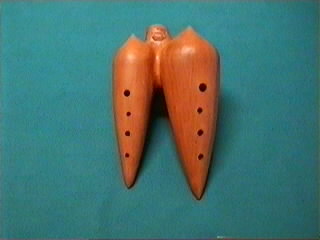
Fabio Menaglio double harmony ocarina tuned in fourths
A different kind of multiple chamber ocarina is designed for the chambers to be played singly most of the time, to extend the range; you switch your mouth between the chambers as if you were playing a pan pipe or harmonica. The usual design (sometimes called "Vicinelli") has the chambers overlapping by one note, so the second chamber starts a tenth above the first and the overall range is about two octaves. A recent alternative is Pacchioni's "Semplice" (now called "Pacchioni") design, where there is a larger overlap, meaning that you need extra chambers (at extra cost) to get the same range, but you have alternative fingerings that avoid a lot of chamber switches and make fast passagework much easier. A Pacchioni "tripla-P" has the same range as a Vicinelli double. Until recently, ocarinas using the "Pacchioni" system were only made by Pacchioni himself, but they are now standard in the product lines of Robert Hickman (Pure Ocarinas), Olivier Gosselink and Christoph Hense, with some Asian makers offering them to special order.
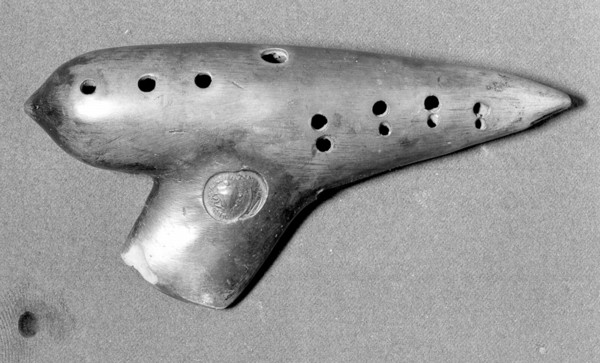
Vicinelli double ocarina from around 1900
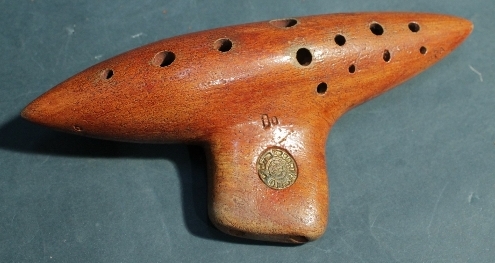
Cesari double ocarina from the early 20th century
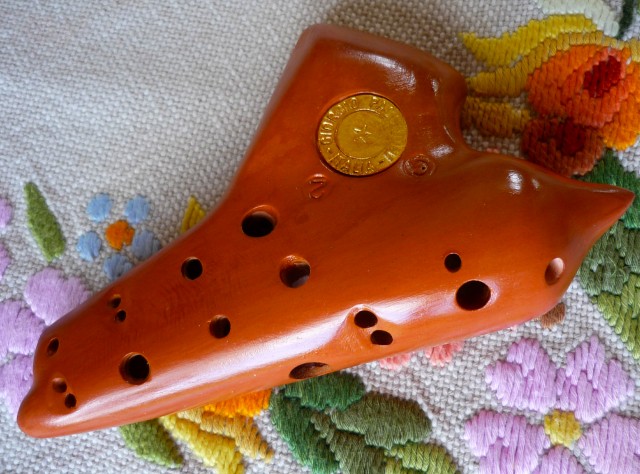
modern Vicinelli-style double by Giorgio Pacchioni (top)
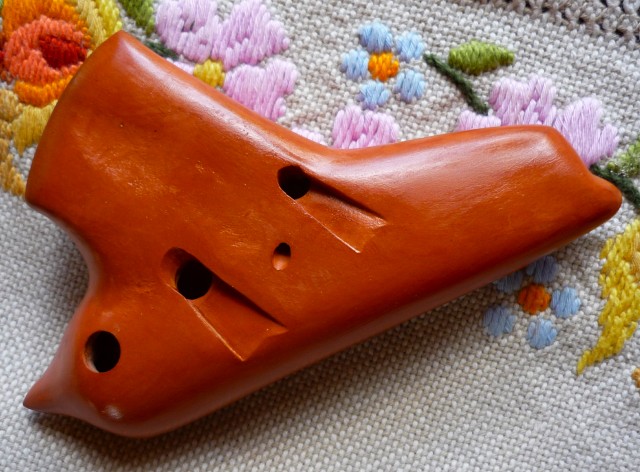
modern Vicinelli-style double by Giorgio Pacchioni (bottom)
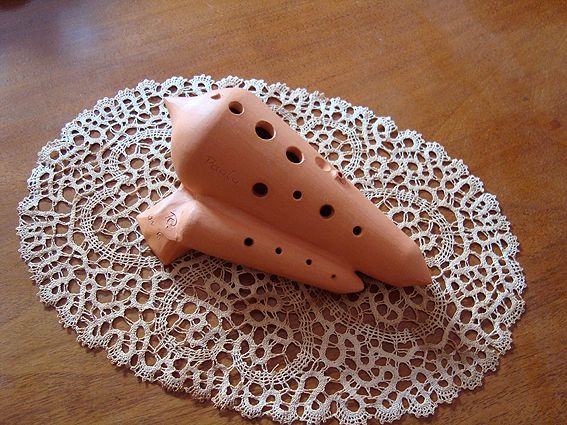
modern Vicinelli-style double by Kurt Posch
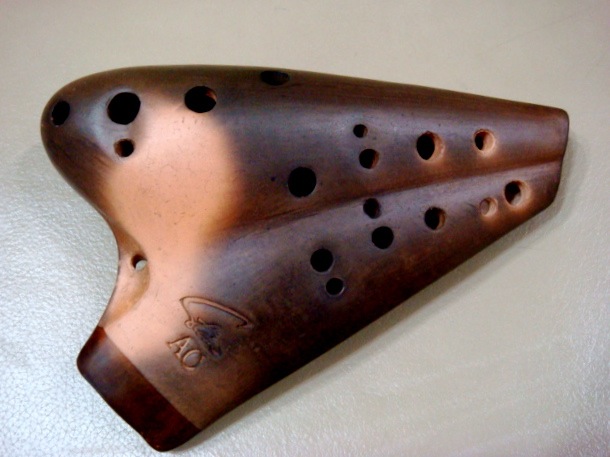
Focalink "Forte" double ocarina
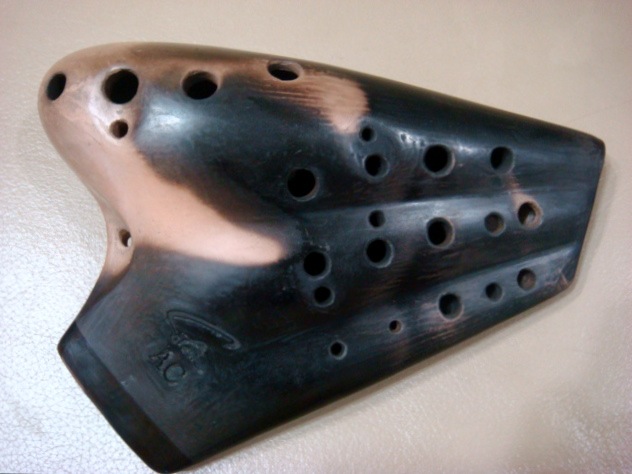
Focalink "Forte" triple ocarina
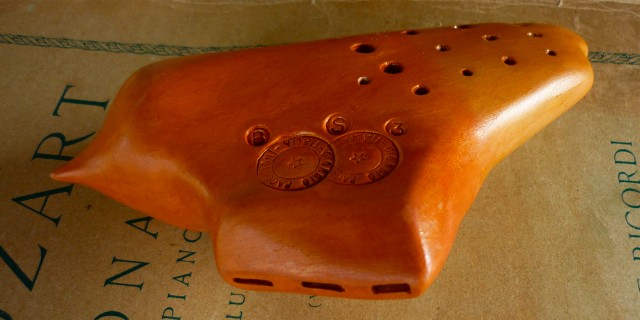
Pacchioni "Tripla Semplice" (top)
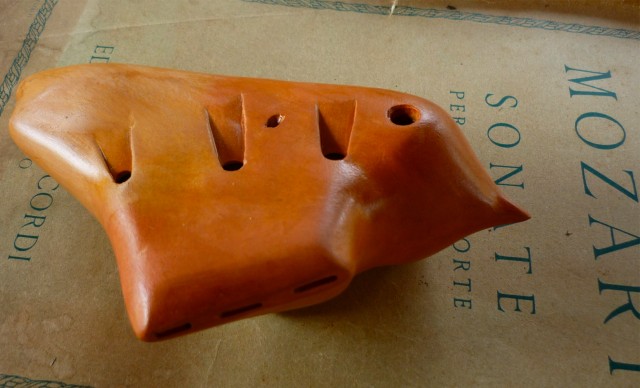
Pacchioni "Tripla Semplice" (bottom)
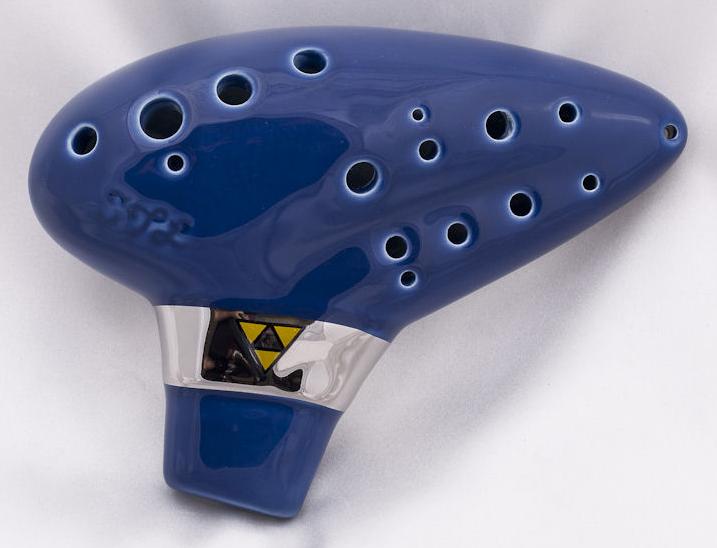
STL Zelda double ocarina
The largest ocarina ever made was the Compton Cube, an extreme bass ocarina used for the lowest octave of the biggest pipe organs. The idea was that in that range you would never need to play more than one note at a time, so it saved space not to use the usual set of single-pitch pipes. No human lungs could ever play one. A later variant was the Polyphone of 1926.
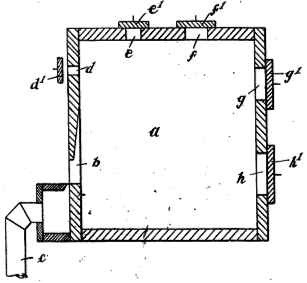
It's like an ocarina equivalent of the square bass recorders invented by Alec Loretto in New Zealand and now made by Kunath in Germany under the Paetzold brand name.
There have been very large ocarinas designed for humans, but they are rare, expensive and look rather silly:
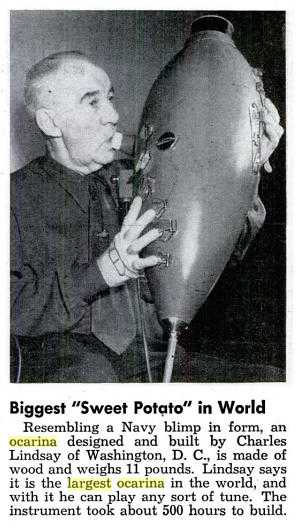
American design from the 1950s
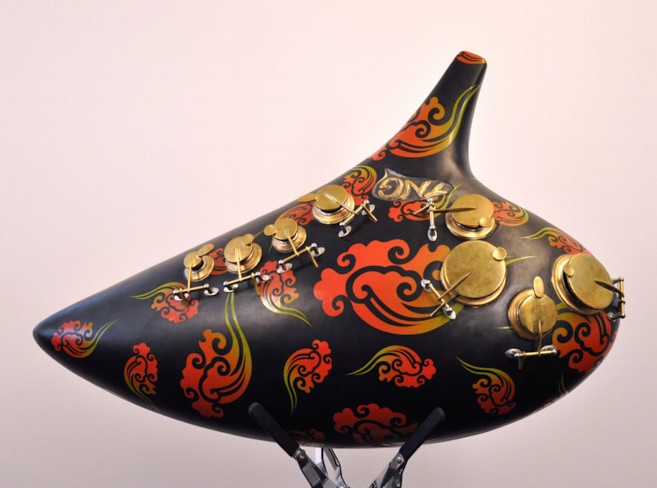
a pig-sized Chinese keyed ocarina going down to the cello's low C
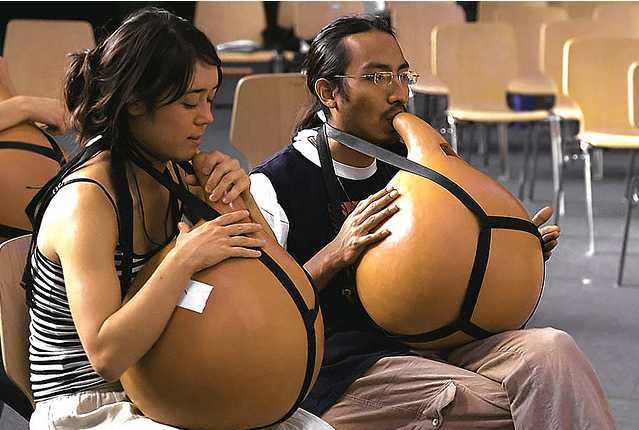
ocarinas with Langley-type "fingering", or rather "arming", where you need to cover the holes with your forearms
sound sample of Claudio Colombo's contrabass ocarina
The ocarina principle has been used in a variety of high-pitched whistles, mainly for signalling:
The referee's whistle and the samba whistle contain a small sphere inside, the "pea", that produces a loud vibrato. The samba whistle has two holes, allowing a range of three notes. Pitch variation in the bosun's pipe is done by bringing the fingers close to the voicing hole, a technique that works on all fipple flutes. Nobody seems to have used the "pea" idea in a general purpose melody instument.
A related instrument is called "xun" (or "hsun") in China and "borrindo" in north-west India and Pakistan. It has no windway, just an open tonehole like a flute. I have tried two xuns; one worked reasonably well, but I never managed to get more than the lowest few notes out of the other - the embouchure is much more difficult than a flute. But it's deeply expressive once you can control it, capable of some extraordinary sobbing sounds. A variant of the xun is the koudi, made of a short fat section of bamboo and blown transversely in the centre, with both fingerholes and the ends opened and closed by the thumbs: it looks like a very small transverse flute but acoustically it's a vessel flute. While based on ancient models, it was invented by Yu Xunfa in 1971. (I have an instrument which seems to be one of these precursors: like a very fat bamboo flute headjoint, where you can vary the pitch by varying the opening at one end with the palm of your hand).
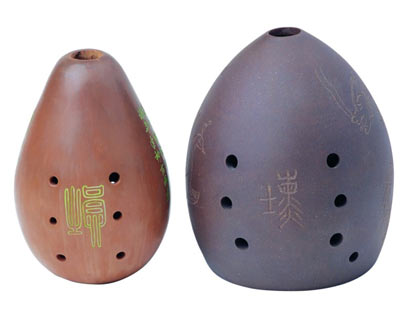
Two xuns, from a website about China in Hausa
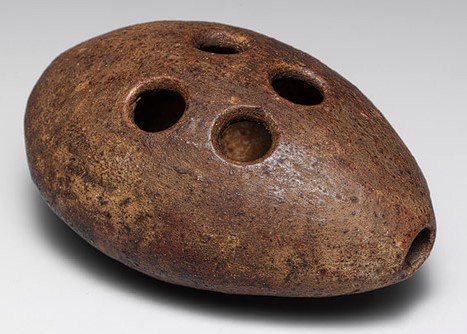
A primitive Han Dynasty xun, from a page at the Metropolitan Museum of Art
The storyteller Bob Pegg points out in his show Roots and Flutes that one kind of xun is the oldest of all wind instruments, and in fact predates human life by millions of years. It sometimes happens that stones on the beach get a hole eroded through them; this can be done by a smaller, harder stone, but more usually by a small bivalve shellfish (the "boring piddock", Pholas dactylus) cutting itself a tunnel to live in.
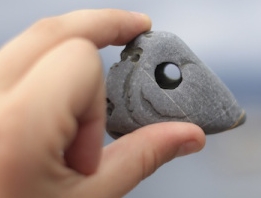
Stone bored by a piddock, from The Hazel Tree blog
The hole may have a sharp enough edge to be blown. Place your finger over the opposite side of the hole and you can get two distinct notes out of it. Simply blowing into a sharp-edged hole must predate the idea of a fipple everywhere, hence there are many instruments of this type around the world. Two African ones are described here:
With no pottery - the technology was lost in the Polynesian migrations across the Pacific - the Māori made several instruments on the xun principle out of gourds, egg shells or (in more recent times) bone. These are described in Brian Flintoff's book/CD Taonga Pūoro: Singing Treasures. The images I've used here are mainly from Richard Nunns' website.
Like all traditional Māori instruments, these are sounds from a lost ecosystem. The whole of pre-European New Zealand was a continual chorus of overpoweringly loud and varied birdsong, and human instruments could only play along with it as an additional voice. A reconstruction of the instruments can never reproduce their setting, which was a soundworld unlike any other that human musicians have ever played in.
Here are some videos of xun-like instruments:
Even more remote from the ocarina in its design is the pucuy from the Comechingon culture in Argentina, which has a slot instead of a circular hole for the embouchure - you partly close the slot with your finger. A fippled version of the pucuy, allowing pitch to be varied by partially closing a slot, is the haggis caller, which doubles as a moneybank (going sharper as you save).
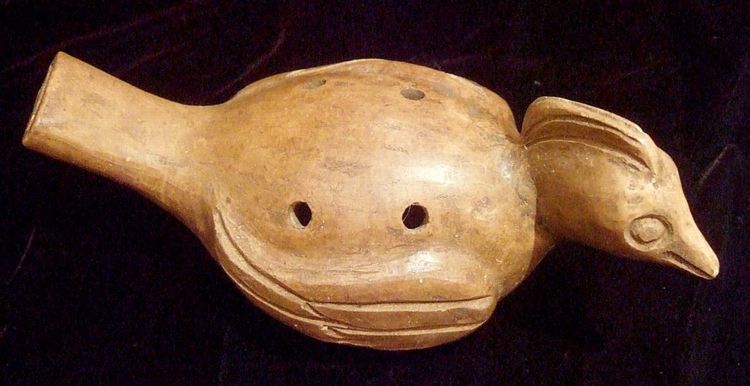
a Central American ocarina shaped like a quetzal bird
Most cultures that have had pottery ocarinas have tried making them in decorative shapes. Birds, frogs, fish, boats, human heads and bodies, and penises (yes, penises, including very realistic penises) have all been done many times, and even when the ocarina isn't shaped like an animal it may be decorated with animal motifs like this jaguar. The ocarina's ritual use in the Americas led to some bizarre imagery, of which this ocarina dedicated to the Flayed God Xipe Totec must be one of the most extreme. Another in the same tradition is this three-headed watermelon-eating zombie with a rectal prolapse, presumably made for the Mexican Day of the Dead:
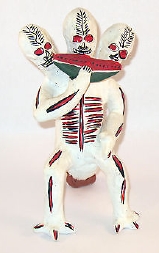
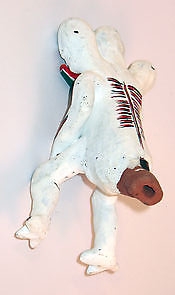
image from Wollemi Pine on The Ocarina Network
Most of these have only had a limited range and were intended as toys or for ritual purposes, or as birdcalls. But they can be real instruments, made with Italian or in-line fingering systems:
Most people in the UK have no idea what an ocarina is. Of those that do, what most will think of when they hear the word is the "Langley" ocarina, a design invented by an English schoolteacher in the 1960s, which is often sold as "Celtic" or "Native American" with decorative motifs to match. It's a round or oval instrument with four fingerholes on top and sometimes two thumbholes underneath.
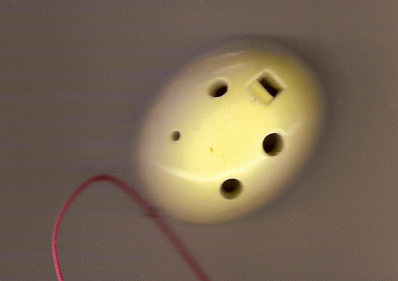
With misplaced ingenuity this makes the fewest holes possible do the most work. The holes vary a lot in size, and the larger ones make a difference of more than a tone to the pitch you get. So the fingering pattern is rather like the coding of binary numbers, and nothing like any other woodwind instrument. Accordingly, if you're coming to the ocarina from another woodwind or expect to play another one after learning the ocarina, this type of instrument is a mistake. It has its own repertoire (mainly music for children) but it takes an enormous amount of effort to play quickly and is next to useless as a general-purpose melodic instrument. The fingerings are so unintuitive that most players will never get past using the tablature sheets that came in the box, so their repertoire ends up comprising "Speed Bonny Boat" and "Amazing Grace", played very very slowly. Here is a maker's demo, presumably doing their best to show what the instrument is capable of:
Given about 20 years practice and 4000 years of tradition you can sound quite good playing an instrument vaguely like that with pentatonic tunes of narrow range:
You will not hear anything like that in the UK. Langley ocarinas are usually sold as children's instruments to parents who don't know any better. The American term for them, "pendant ocarinas" makes a lot of sense - they can look good as jewellery, like this one made for Songbird Ocarinas in the US by a Chinese maker (photo by Mark Chan):
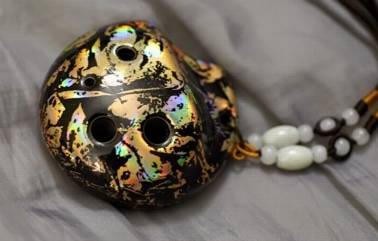
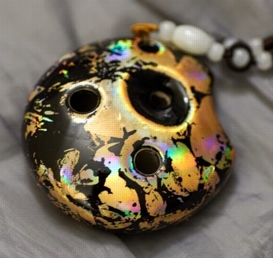
Taichi pendant ocarina with opal glaze effects
Most makers of pendant-type ocarinas don't make fingering charts generally available. This is one for the Songbird 6-hole, which uses both thumbs and the first two fingers:
left right
==== =====
C do T12 t12
^C de T12 t12/ (half-hole)
D re T12 t1-
_E ma T12 t1/2
E mi T12 t-2
F fa T12 t--
^F fe T1- t12
G so T1- t1-
^G se T12 t-2
A la T1- t--
_B ta T-- t1-
B ti T-- t-2
c do T-- t--
^c de -1- -1-
d re T-- ---
_e ma --- -1-
e mi --- ---
But most pendant players use this kind of thing (until they give up with boredom, which doesn't usually take long):
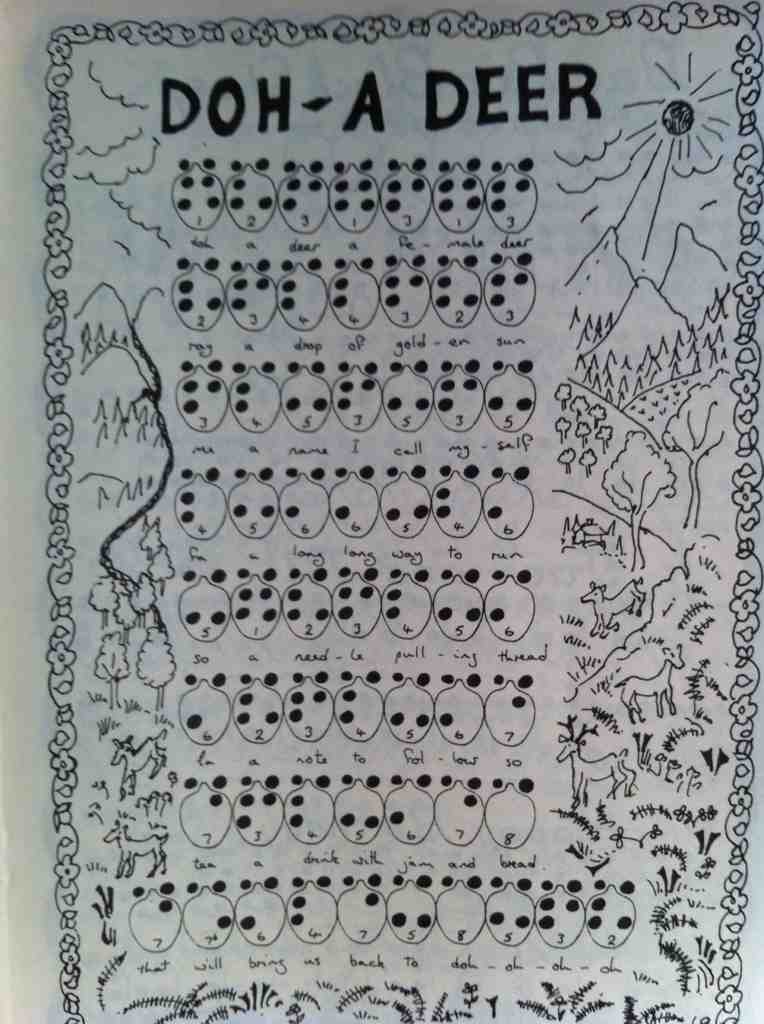
One Chinese maker's 6-hole pendant designs make a political point:
Ocarinas in Landmine style: In the second world war, the Japanese aggressed against China. local militias in Shandong province overcome many difficulties and made various landmine with stone with their wit and creativity although they lacked of iron. They used these stones mind to resisted Japanese invaders. I designed these ocarinas in order to memorial of local militias and memorial of MAO zedong's military theory: "people's war"
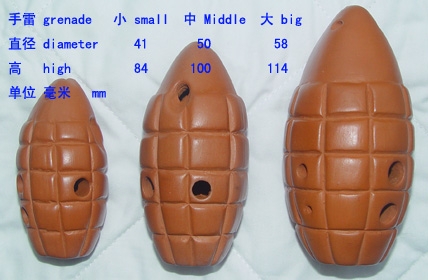
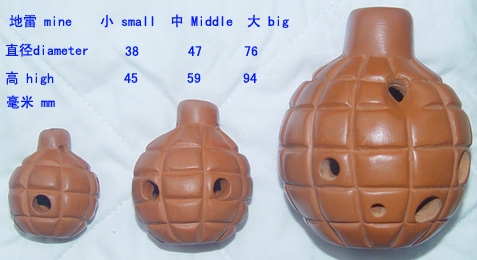
Good luck trying to take one of those on a plane.
You may also come across real Native American ocarinas in "fair trade" shops. They are usually the same basic shape as the Langley, but have seven or eight holes allowing you to play a scale by taking fingers off successively, like a normal woodwind. The problem is that because the holes are of equal size, the scale you get is nothing known to Western music and no two of them seem to be tuned the same. But you can retune them with a file (to enlarge holes) and nail varnish, tape or glue (to reduce them) and end up with a more usable instrument. Their basic sound can often be reasonable.
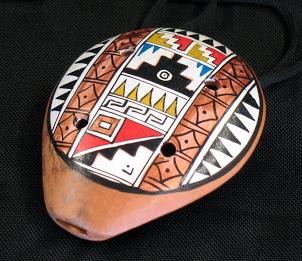
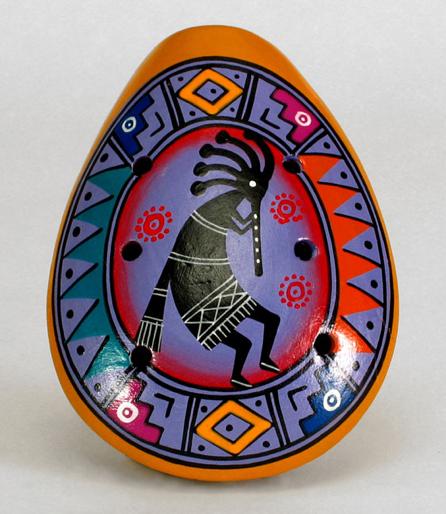
I have never seen any kind of notated music for these, or any demo CD you could use to learn from. The makers don't even pretend they're a genuinely usable musical instrument. Their main effect is to make the "fair trade" movement look like a rip-off.
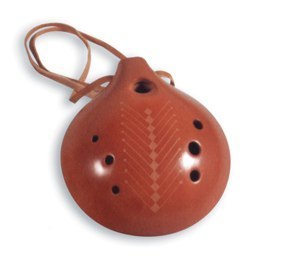
Arcoiris tenor ocarina
By far the best-selling ocarina in the world is the Smule iPhone ocarina. Its fingering system is like a Langley, as far as I know. You don't see any great displays of virtuosity on it. This is about as good as it gets:
Paolo Gavelli has experimented with electro-acoustic ocarinas, accompanied by a small effects processing unit. One of them is based on a Woodsound bass ocarina:

Gavelli Woodsound electric bass ocarina
I haven't heard any sound samples of it.
The acoustics of the ocarina in some ways resembles a Helmholtz resonator. This was an experimental tool invented by Hermann Helmholtz in the 19th century, and documented in his book On the Sensations of Tone. A Helmholtz resonator didn't create any sound; it resonated at one very specific frequency to sound fed into it, so you could use it to detect that frequency in a complex mix of sounds. The characteristic frequency was determined by only three factors: the volume of the resonating chamber, the area of the open hole, and the length of the hole (in many cases this would be the thickness of the wall of the chamber).
Any ocarina maker could tell you ocarinas are not that simple. The geometry of the sounding edge and its hole makes a large difference to the pitch produced, so much that nobody can make ocarinas purely by calculation - it usually takes a maker many tries to get a design whose basic pitch and range of possible pitches is close enough to the intended one that making it in volume becomes feasible.
The simple design of a Helmholtz resonator, with one open hole, makes the shape of the chamber irrelevant. Again, this is not true for the ocarina: internal features are often made around the holes to balance the response across the range, and because the instrument is blown, air currents can destabilize the tone, so that holes have to be moved to the right places relative to the windway.
For a player, the important difference between an ocarina and a Helmholtz resonator is that the pitch of an ocarina is variable depending on your breath pressure.
There are presumably Facebook pages about the ocarina. I don't have a Facebook account and have no intention of finding out about them.
There are regular get-togethers of ocarina players and makers in several countries. The largest is an annual festival which alternates between Budrio and somewhere in the Far East. The next festival will be in Budrio, 1-3 May 2015. A much smaller one is held in the Po delta in alternate years (i.e. when the main festival is in the Far East). Smaller meetups are organized through internet forums; I know of past events in the US, the UK and Hungary.
There are ocarina museums in Italy and Korea:
I have a hard time believing this really exists even while listening to it, but:
It seems to scan all known internet radio streams for mentions of "ocarina" in the programme listing. Here is Nancy Rumbel in a programme about birds, playing along with a Common Potoo on her ocarina.
The ocarina has occasionally featured in literature; usually in unflattering stereotypes. From the introduction by J.B. Atkins to Edward Granville Browne's A Persian Anthology, 1927, in a biographical sketch of the author, describing his college days in Cambridge around 1880:
Here some undergraduate says, "Johnny, didn't you play yourself on the ocarina?"."No," says Johnny, "I didn't. I used to try sometimes, because Blank in my year had an ocarina. The man in the rooms above him had to leave in consequence. And later on there was a regular movement against the ocarina, which was seized and smashed up. I was very glad..."
In Annie Proulx's grim first novel Postcards, the "swirled novelty pattern of the Bakelite" describes a Gretsch:
Something was sticking in his backside, and he felt around, grasped Memelle's ocarina, the swirled novelty pattern of the Bakelite scarred from kicking around the floor. On the sides were decals of donkeys carrying panniers of cactus. He started to crank down the window to throw it out, but the window slipped off the rail again when it was only a crack open, and he threw the ocarina into the backseat.
and later in the book:
"Anybody wasn't raised in a South Dakota hen coop and sent to the Badlands for finishing school knows that the ocarina started out as a prairie chicken call. Roy Orbison invented it with the prairie chicken in mind."
There are present-day makers of Italian-type ocarinas. My newest one is by Fabio Menaglio, still working in Budrio where the ocarina was invented and probably closer than anyone else to the original idea for the instrument. Here is his factory, its architecture redolent of centuries of craftsmanship:

Italian-type ocarinas show up on EBay every week, more often in the US than the UK. The commonest types you see there are the terracotta models made by H. Fiehn or EWA in Vienna before WW1, and American-made bakelite ones. EBay France is worth looking at for Mathieu metal ocarinas.
I have a few Fiehn/EWA models but haven't tried one of the US military types. When buying from EBay, you want to check the range as well as the pitch - it's not a disaster if the top note or two is unplayable, but it may affect what you pay for it. Tunable ones can be very expensive. As a general rule, the more worn and scruffy the instrument is, the better it is (assuming nothing irreplaceable has been broken) - that shows it's been used intensively.
An early reference to the ocarina in Scotland is from 1890, when Mezzetti displayed his tunable ocarinas at the International Trade Exhibition held to mark the opening of the Forth Bridge. At the end of it, he held a concert:

The Scotsman reviewed the concert the day after:
OCARINA CONCERT IN EDINBURGH.- An entertainment of a somewhat novel character was held in the Masonic Hall, Edinburgh, last night, when a concert was given by Signor Mezzetti, in which performances on the ocarina formed the principal attraction. During the recent International Exhibition the ocarina became quite a popular instrument in Edinburgh, largely owing to the efforts of Signor Mezzetti himself, who gave performances daily in one of the courts; and the numerous audience in the Freemasons' Hall last night bore ample testimony to the public appreciation of his musical ability. He was assisted by a small but competent company of vocalists and instrumentalists, some of whom were, like himself, trained in the mysteries of the ocarina. The concert proved a very enjoyable one.
The preview of the exhibition mentions tunable ocarinas specifically, which suggests that ordinary ones were already well known.
Mezzetti collaborated with the Edinburgh music teacher Walter Wyatt, who prepared a tutorial on the ocarina using the tonic sol-fa system and also wrote a polka for two ocarinas and piano, Mabel, dedicated to his daughter.
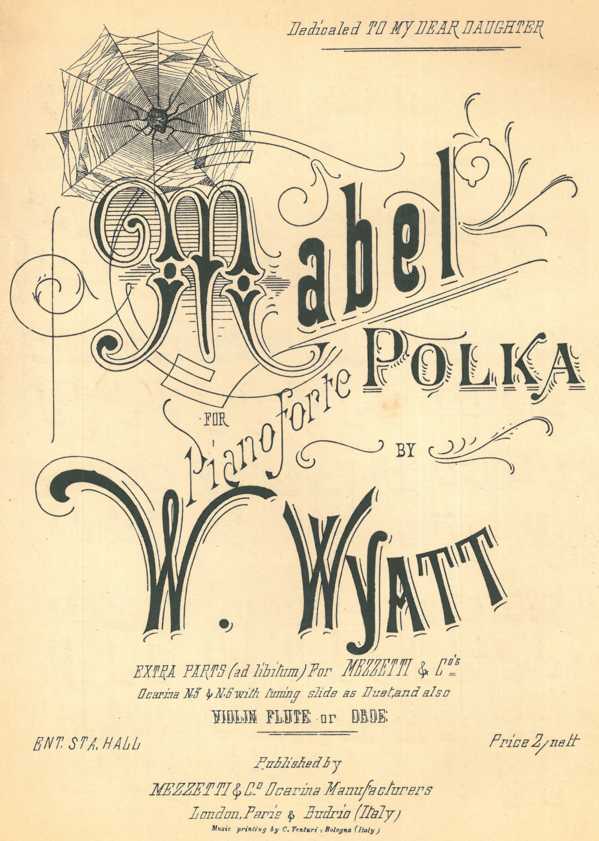
I have put scans of these here: Walter Wyatt ocarina music
The earliest recordings of ocarina playing I know of from Scotland were by Willie Kemp. He is best known as a traditional singer from the north-east of Scotland, but also played the ocarina. The track available on Spotify beginning with "Mackenzie Highlanders" is a sample of his style (accompanied by a melodeon). On some of the other tracks he plays the jew's harp (or "trump" as it was often called in Scotland). These recordings are from around 1930. They were re-released on the Scottish label Sleepytoon Records a few years ago, but the Spotify versions come from "Voice of the People", a vast compilation of British traditional music. The beginning of the Spotify track is also available in MP3 (much worse quality) at http://www.sleepytown.co.uk/curly.mp3 . That's a sample from the Sleepytoon CD, http://www.sleepytown.co.uk/YCD02.htm. The disc is reviewed at http://www.mustrad.org.uk/reviews/kemp.htm.
I used to play with an old mouth organ player, Iain Grant, who came from the same part of the country. He told me that when he was a kid (around WW2), ocarinas were widely available there, at about the same price as harmonicas. These were the plastic sort, like those made for the US military in WW2. Iain went for the harmonica instead, as did other players of his generation, and after Willie Kemp, nobody really followed on with the tradition. I play the same sort of tunes as Kemp does on that Spotify track, and in a somewhat similar style (he does more slides, I do more gracenotes), but the similarity is due to evolutionary convergence rather than influence - I'd heard of Kemp's playing years ago but I'd been playing the ocarina long before I first heard him.
One of my ocarinas is a Mathieu low B flat I got off EBay, which had been left unsold at an auction house in Inverness. I couldn't trace its ownership back beyond that, but it's a good bet that Willie Kemp knew whoever played it. I have another ocarina (an unbranded Austrian ceramic 9-hole) which dates from before WW2 and was once played by a farmworker from Northamptonshire; it's heavily worn, he must have used it regularly for years (his favourite tune was "Greensleeves"). An easily portable instrument like the ocarina makes sense for an agricultural labourer, whether from England or the farmtouns of Aberdeenshire.
Another recorded Scottish ocarina player was Watt Nicoll, who used it in the 1960s as part of an act that also included singing and the tin whistle. I haven't heard any of his playing yet. There is a discography at Nigel Gatherer's site.
I have been told that in the Edinburgh area in the Fifties, plastic ocarinas were sometimes given away by rag and scrap metal collectors. If anybody knows more or has one of the instruments they gave away, I'd like to hear from you.
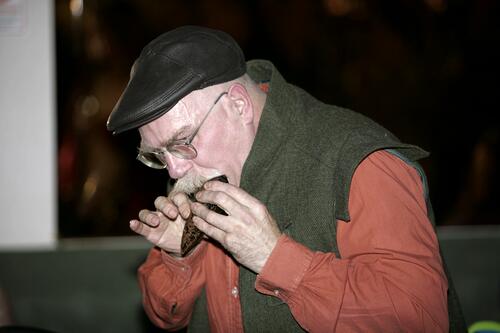
at the Selkirk Sessions festival 2006; © Ian Oliver, LRPS. Fiehn ocarina in C#.
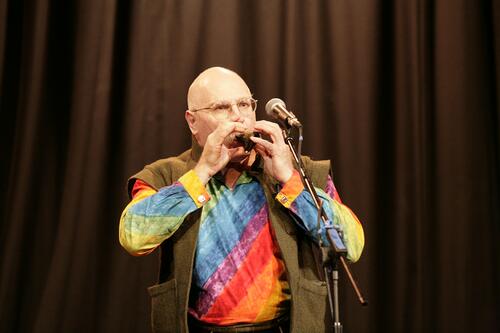
at the Selkirk Sessions festival 2006; © Ian Oliver, LRPS. Fiehn ocarina in C#.
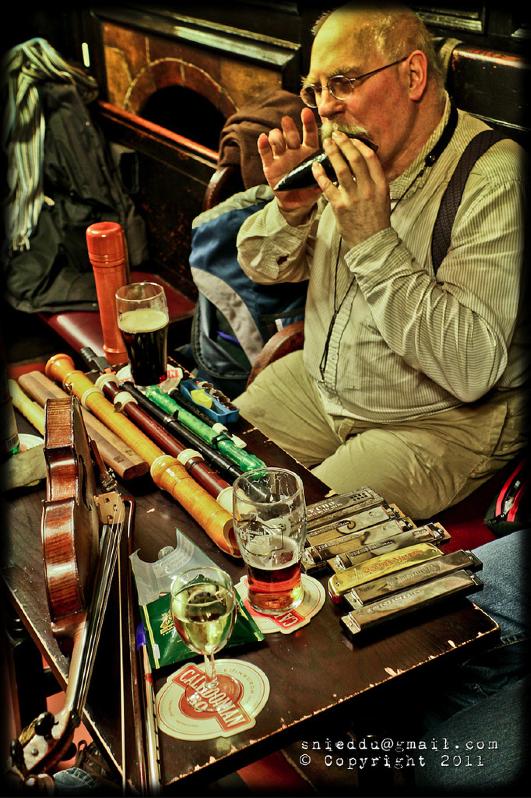
In Sandy Bells, Edinburgh, 2011. Austrian alto G ocarina.
A question: some time in late 2006, BBC Radio 3's "Late Junction" programme played some Kurdish ocarina music. I haven't found any more about it, and Late Junction isn't answering emails. Googling for the obvious keywords gets no useful hits, and a bizarre one where a Greek government site invented a Kurdish activist called Abdullah Ocarina by applying the Microsoft Word spellchecker to a document about Abdullah Öcalan. If anybody out there knows more, and in particular where to get that recording, please let me know.